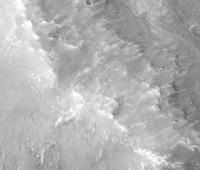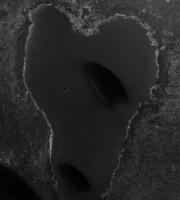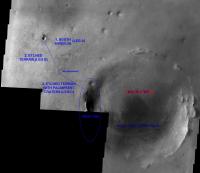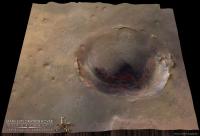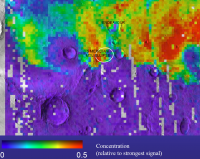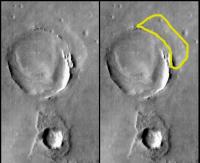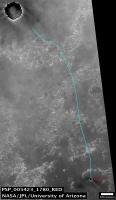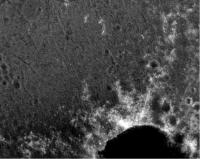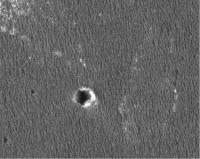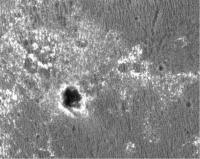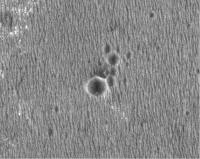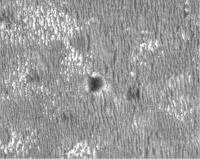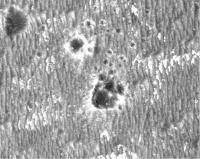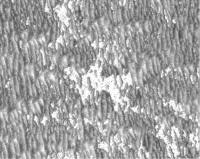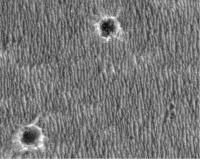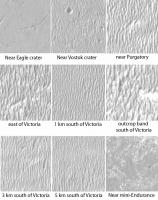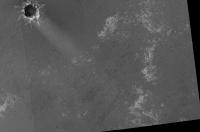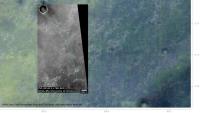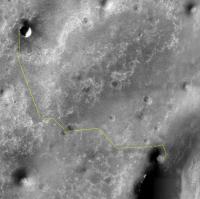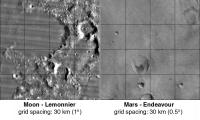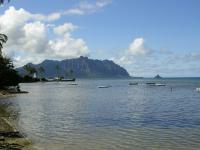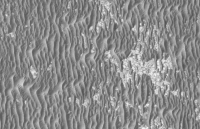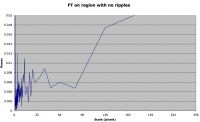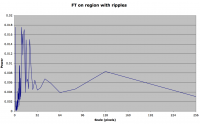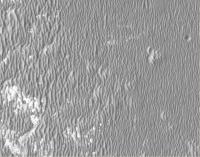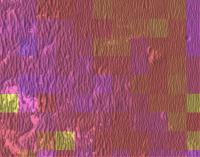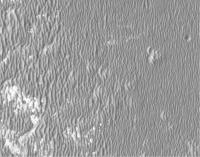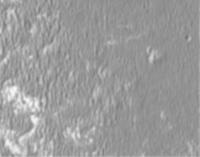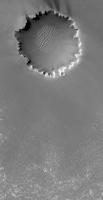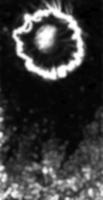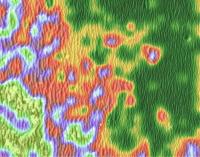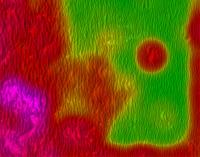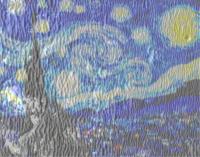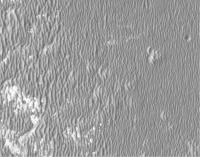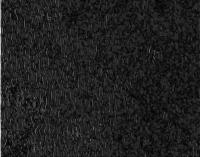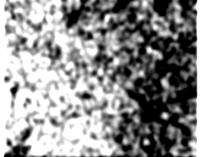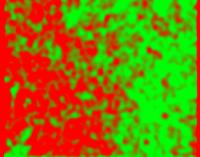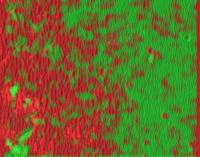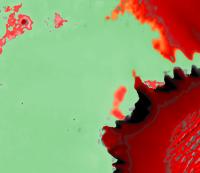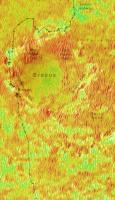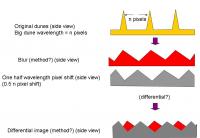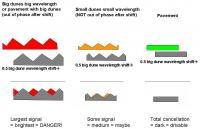Printable Version of Topic
Click here to view this topic in its original format
Unmanned Spaceflight.com _ Opportunity _ Endeavour Drive - Drivability analysis
Posted by: djellison Sep 18 2008, 11:05 AM
http://www.sciencefriday.com/program/archives/200809191
You can listen via NPR, or via one of the web feeds that are listed on the site, but make sure you do listen if you can.
Posted by: djellison Sep 19 2008, 06:01 PM
Tune in now
Posted by: djellison Sep 19 2008, 06:08 PM
"What's next for Opportunity - time for another martian road trip - perhaps a really long one?"
Posted by: djellison Sep 19 2008, 06:14 PM
Paraphrasing Squyres :
Well, we've exhausted the easy places - time to do something hard
Bold, difficult, maybe impossible.
To the SE of this at a distance of 12km, 7 miles is an enormous crater - we're going to head of towards it. I think it could take a couple of years.
We think we can drive a lot faster than we have in the past.
We're rolling the dice in a sense - we think it's the right direction to go anyway.
Alfred McEwen -
Rui.... you have clearance to explode.
Posted by: Tman Sep 19 2008, 06:30 PM
Posted by: mhoward Sep 19 2008, 06:52 PM
NO! WAY!
You guys must be pulling my leg. If not, this is the grandest news I've heard in a couple years.
![]()
![]()
![]()
Posted by: dvandorn Sep 19 2008, 06:58 PM
Last I checked, the date isn't April 1....
-the other Doug
edit -- by the way: YAHOOOOOOOOO!!!!!!!
Posted by: imipak Sep 19 2008, 07:23 PM
Harrumble!! ![]()
Posted by: David S. Sep 19 2008, 07:30 PM
That's just amazing !! This is going to be one hell of a route map to maintain ![]()
Posted by: paxdan Sep 19 2008, 07:34 PM
mars EXPLORATION rovers
Am delighted by this news.
Posted by: tedstryk Sep 19 2008, 07:44 PM
Awesome - we may not get what we want, but I'd rather Oppy die trying than miss out on some great science by trying to be safe at this point. ![]()
![]()
![]()
Posted by: Pavel Sep 19 2008, 07:51 PM
That's Ithaca crater!!! It cannot be anything else!!! Let's go to Ithaca now and hug Steve Squyres!!! ![]()
Posted by: djellison Sep 19 2008, 07:53 PM
Sorry - if I didn't make it clear - yes - it is - and they've named it Endeavour
Posted by: vjkane Sep 19 2008, 07:59 PM
As an American taxpayer, I must say that I wish all government programs produced the returns and guts of this one!
Thank god for flat terrain. 12 km is a long way at rover speed and forever if you have to keep dodging obstacles.
Posted by: centsworth_II Sep 19 2008, 08:02 PM
I knew it all along. ![]()
![]()
Just think, a couple years from now opportunity may be upstaging MSL!
Posted by: odave Sep 19 2008, 08:04 PM
That was quite a show; an all-star panel plus the full hour on Mars.
Steve did say that they wouldn't even attempt the trip without HiRISE, and they'd be shooting for 100m/day.
Posted by: djellison Sep 19 2008, 08:07 PM
Just got word from SS - the name Endeavour is unofficial at this stage.
Posted by: ElkGroveDan Sep 19 2008, 08:08 PM
I hate to spoil the party, but (as the saying goes) has anyone else noticed the elephant in the room?
http://www.planetary.org/news/2008/0731_Mars_Exploration_Rovers_Update_Spirit.html
Posted by: charborob Sep 19 2008, 08:12 PM
According to this old http://marsrovers.jpl.nasa.gov/newsroom/pressreleases/20071015a.html, the funding for the fifth mission extension of the MER rovers carries them "possibly through 2009". If Opportunity is still alive then, let's hope that the funding will follow for another extension.
12 km at 100m/day is only 4 months, though ![]()
Posted by: Paolo Amoroso Sep 19 2008, 08:17 PM
This is a marsathon.
Paolo Amoroso
Posted by: Vultur Sep 19 2008, 08:24 PM
WOW. This is incredible news. I wonder if Oppy can really make 100m/day reliably?
Posted by: djellison Sep 19 2008, 08:28 PM
Every day? No.
But back in the day - James Caird to just before Purgatory was getting on for 1.5km in 30 days.
Doug
Posted by: Tesheiner Sep 19 2008, 08:34 PM
Unbelievable! Incredible! Wonderful!
![]()
![]()
![]()
Now, if we don't have news about Rui/Ustrax in the next hours/days I will be very worried. Such news might be too much for his heart. ![]()
Posted by: brellis Sep 19 2008, 08:46 PM
This Big Crater fan says Yahoooo!! ![]()
Posted by: Paolo Amoroso Sep 19 2008, 08:46 PM
This would be the largest crater on another world ever visited so close at ground level, right?
Paolo Amoroso
Posted by: charborob Sep 19 2008, 08:56 PM
Lunokhod 2 landed inside LeMonnier crater, but I didn't check how big it is compared to "the big crater"
Posted by: fredk Sep 19 2008, 09:03 PM
And we can't forget Gusev crater!
A new adventure! I can't wait to start the new road trip! ![]()
![]()
Posted by: Shaka Sep 19 2008, 09:09 PM
Don't forget Gusev. ![]()
So passes the torch...from Victoria to Endeavour... From Magellan to Cook...from Portugal to Yorkshire...awesome!
No one can say our Mighty PIs lack ambition or audacity.
Let it be! Southward the wagons! ![]()
Posted by: ustrax Sep 19 2008, 09:12 PM
I am experiencing so many different amazing feelings...so many...
Spirit and Opportunity drive me to tears... ![]()
Are you guys aware of the magnificency of this mission? Yes you are... ![]()
Besides the fantastic technical achievement, the rovers seem to be part of a tale, of a story that previously written wouldn't sound so epic!
THEY are legend...
And the people making it happen...wow...you make us believe that EVERYTHING is possible.
Opportunity, dear Opportunity...take us to Endeavour...make of http://www.youtube.com/watch?v=1n3n2Ox4Yfk&feature=related your fuel! ![]()
Posted by: djellison Sep 19 2008, 09:18 PM
Rui, do you not approve?
![]()
Posted by: ustrax Sep 19 2008, 09:36 PM
Doug...from this guys? Whatever they want whenever they want!
Man...http://www.unmannedspaceflight.com/index.php?s=&showtopic=3215&view=findpost&p=68929 keeps banging in my head for a long time...
We're mad?...
What about Squyres and friends?! ![]()
Tesheiner...ready for some years of hard mapping? ![]()
Posted by: aldo12xu Sep 19 2008, 09:39 PM
Coming out of lurk mode to say this is simply incredible news! It reminds me of when it was decided to drive to and climb the Columbia Hills. Yes, 12km is a long way off but, man, these machines and the JPL team have proven themselves over and over. It's testamant to all that's good about the human spirit.
A toast to Opportunity! (Where's that virtual beer??)
Long may she rove!!
Cheers everybody,
Aldo.
Posted by: mhoward Sep 19 2008, 09:52 PM
I'll drink to that. This news makes me proud to be a human being. It's simply inspiring. It doesn't matter if Opportunity ultimately makes it there - what matters is that the attempt is made.
Okay, yes - actually getting there would be fantastic, too. But who knows what we might find along the way?
Posted by: Bobby Sep 19 2008, 09:54 PM
Even Obama or McCain can't outdo Opportunity
Does anyone have any overhead pictures of the area between Victoria Crater and Endeavour Crater.
From the overhead shots. Which way should we go. Are there anything interesting along the way that
we should stop at??? I figure we should start the trip now and study the cobbles and anything else down
The Yellow Brick Road ![]()
Posted by: ustrax Sep 19 2008, 10:06 PM
Precisely...that is why I find that Ithaca poem so inspiring...so terribly fitting for this crazy, C-R-A-Z-Y odyssey...
And proud...yes...we're sharing the same view...just sent some words to our Master and Commander that reflect that feeling:
"A whole new adventure ahead, so many things to see, explore and learn about...
So many miles of amazement, terrestrial dream and martian reality...
From deserts to mountains, from drama to epic achievements, from here to there, from question to answer...
You, your team, Spirit and Opportunity, make me so proud of mankind!"
Doug...wouldn't it be possible to, somehow, gather the work done by some guys here regarding possible paths to Ith...sorry...Endeavour, and merge in a single thread?
Posted by: Ant103 Sep 19 2008, 10:08 PM
As Mr Burns said : "Excellent!"
Yes, excellent news. I can't believe this. This seems to be so … unrealizable. But Oppy shows us so many thing we believe unrealizable.
So, GO Oppy, go ![]() .
.
Posted by: Stu Sep 19 2008, 10:21 PM
Just catching up on the Big News, having been out during the evening...
I know that when we discussed this possibility earlier I was very cynical about setting off on such a long trek, but I'm happy to eat my words and to have been proved wrong. It shows just how brave the MER team are, and how determined they are to squeeze every last precious drop of knowledge out of this mission before it ends.
And I'm happy for ustrax, too. Always the optimist, always the explorer, always the adventurer. Walking alongside Oppy every inch of the way with a hand on her back, saying "Onwards... onwards..."
And off we go...! ![]()
Posted by: ustrax Sep 19 2008, 10:24 PM
Just got some words from SS...I never doubted that he was one of ours...the "Rove till Death Brotherhood" ![]()
"Well, we'll see what happens. The wheels could fall off tomorrow, after all... this is an old rover! But this is a good direction to travel whether we get there or not, as I explained in the interview. And, to me, this goal just >feels< right. Better to attempt something nearly impossible and die trying than simply live out our time doing things that have been done before."
Yeap...it feels soooo damn right! ![]()
Rovers parked in craters... ![]()
Posted by: Sunspot Sep 19 2008, 10:40 PM
This is sooo exciting !!!! ![]()
Don't we have a picture of this crater somewhere? I'm trying to recall what it looks like.
Posted by: elakdawalla Sep 19 2008, 10:45 PM
I found a good CTX image and posted it in http://www.planetary.org/blog/article/00001653/; for lower-res but wider-field images the best bet is HRSC. Here's http://hrscview.fu-berlin.de/cgi-bin/ion-p?page=product.ion&code=61004678&image=3220_0001 (preview and links to others http://hrscview.fu-berlin.de/cgi-bin/ion-p?ION__E1=UPDATE%3Aion%3A%2F%2Fhrscview.ion&image=3220_0001&image1=4+images&lat=-2.000&lon=354.465&zoom=2&mode=mars&scale=100&pview=North&exag=1.5&viewport=720x360&UPDATE=Update+view&image0=3220_0001&code=88139573). I can't download and mess with them because I'm at the in-laws', with a less-than-reliable connection; someone else here please have at it!
--Emily
Posted by: ustrax Sep 19 2008, 11:02 PM
Sanguine?!... ![]()
Sunspot and Emily, http://www.unmannedspaceflight.com/index.php?s=&showtopic=4234&view=findpost&p=109222 covering the whole crater with the available images at the time.
And a http://www.unmannedspaceflight.com/index.php?s=&showtopic=4234&view=findpost&p=109289 just to reignite this discussion... ![]()
Oh boy oh boy...Xmas has arrived earlier this year...this will be sooo cool!
EDITED: And a beautiful Endeavour http://hrscview.fu-berlin.de/cgi-bin/ion-p?ION__E1=UPDATE%3Aion%3A%2F%2Fhrscview.ion&image=3220_0001&image1=4+images&lat=-2.272&lon=354.814&zoom=2&mode=mars&scale=75&pview=North&exag=1.5&viewport=720x360&image0=3220_0001&code=50442473&UPDATE.x=360&UPDATE.y=190 including Victoria... ![]()
Posted by: MahFL Sep 19 2008, 11:08 PM
Wow, I always wanted to go there.
Posted by: BrianL Sep 19 2008, 11:20 PM
The Yellow Brick Road
And now to bring everyone back down to Earth, I figure it's going to be awhile before they set out. The new HiRise images won''t come until Oct 10, and then I figure there will be much planning done on a feasible route. MER time seems to move much more slowly than UMSF time. I see them puttering about the vicinity on their cobble-quest until late in the year. Maybe we need a poll on when everyone thinks The Really Big Trip will commence.
Posted by: mhoward Sep 19 2008, 11:32 PM
I'm guessing you are probably correct about it being awhile before they set out. However, considerable area extending to the south and somewhat east of Victoria has already been covered by MRO. The new image they are referring to may be to cover the remaining distance to Endeavour.
Posted by: Vultur Sep 20 2008, 01:17 AM
Looking at the image of Big Crater/Endeavour in this post, it seems like the crater walls are higher in two areas directly across from each other - the east and west ends. Neither the north rim nor the south has high walls. I wonder why?
Posted by: marswiggle Sep 20 2008, 01:30 AM
Seems that at least two HiRISE images of Endeavour itself already exist, http://hirise.lpl.arizona.edu/PSP_005779_1775 and http://hirise.lpl.arizona.edu/PSP_007849_1775. In colour, too.
One of them includes the southern part of the western rim, a crop of which I'm attaching a bit hesitatingly (not knowing exactly what I see). This picture was exported as a half size jpeg from the quicklook jp2 product.
Added yet another half-res crop showing a curiously shaped pattern inside the crater bowl.
Posted by: Zeke4ther Sep 20 2008, 01:58 AM
This is truely amazing news. The journey will be awsome. ![]()
![]()
![]()
Posted by: belleraphon1 Sep 20 2008, 02:37 AM
Ah.. ITHACA....
What a delight....
"I went to it with the defenseless disposition
with which we approach the unknown,
expecting a greater answer than our painful question."
Ithaca By Francisca Aguirre, Ana Valverde Osan
Travel onward little rover... we are with ya!!!!
Craig
Posted by: HughFromAlice Sep 20 2008, 03:17 AM
Getting pointed to podcasts like this and then to see the discussions afterwards is one of the reasons that I enjoy UMSF so much!
Steve Squyres comments: To me, three interesting things stood out.
1 - Due to combination of software updates, smarter team and HiRise imaging he is expecting Oppy to average 100 metres a day or "even better."
2 - He made no mention of the extent to which potential wheel problems were factored in in terms of choosing this long range target.
3 - He said that they'll be going in the right direction anyway. Rocks from deeper stratigraphic layers thrown a long way from Endeavour/Ithaca crater.
Made me think.....
1 - Even better? That's an exciting target!! Can it be done?
2 - I admire a team that knows when to think like explorers! What is the % probability of reaching Endeavour/Ithaca? Any predictions? Me (optimist) - 80%.
3 - Nearest ejected rocks how far from Vic crater?
Posted by: MarsIsImportant Sep 20 2008, 03:37 AM
Wow!!! Wow! Triple Wow!
Honestly...they said it might take two years to get there. So, I give it about a 30% chance of actually making it to a rim. I have no idea what condition is will be in at that time. The really interesting stuff is along the interior and north of the South rim. That would be shear heaven if Oppy could get there; but that almost doubles the trip length. I don't think that is possible.
This is such a large crater that they need to pick a rim to go to before they start the trip. It might make a big difference as to the path they take.
Posted by: CosmicRocker Sep 20 2008, 05:41 AM
Outstanding! I'd like to say so much more, but you people have used up all of the relevant superlatives, and have even invented a few new ones. ![]()
For those of you who, like me, missed the original webcast, here is a link to http://www.npr.org/templates/story/story.php?storyId=94802645&ft=2&f=510221.
Just to put things into perspective for readers who may not be as familiar with the history of the rovers as some of us MER addicts, 12 km is approximately as far as Opportunity has already roved since it landed in Eagle Crater. As of the latest update, it has gone about 11,782.10 meters (7.32 miles).
"Well, we'll see what happens. The wheels could fall off tomorrow, after all... this is an old rover! But this is a good direction to travel whether we get there or not, as I explained in the interview. And, to me, this goal just >feels< right. Better to attempt something nearly impossible and die trying than simply live out our time doing things that have been done before."
Yeap...it feels soooo damn right!
I agree, Rui. We're all attracted to the MERs by the exploration aspect of this http://www.google.com/search?q=define%3Apioneer. Let's get on with it. It is not necessary to delay in this area, unless the team feels they have unfinished business here. We have enough HiRise and other imagery to get started. They should have plenty of time to analyze the October 9/10th HiRise imagery before before they run out of driveway.
..............................................................
It was great to get this very nice update from several Mars exploration teams, but NPR's http://www.google.com/search?q=click+and+clack format for this program was seriously annoying to me. This isn't funny, it's science, and it's serious. That is not intended to be overly critical. It was an excellent program that covered many aspects of the discussion, from geology to biology, and various areas in between. I'm happy about that aspect.
I would like to hear more about the columnar jointing and other theories that were discussed.
Posted by: BrianL Sep 20 2008, 06:40 AM
That might not be the best approach. As was pointed out by Doug in the earlier discussions, there appear to be significant ripples on the direct path. I think the suggestion was a better route might be to head NE before heading south. This journey will be long enough and hard enough without getting part way then being forced to turn back. I would wait for the complete picture before committing to a route.
Of course, that's the intellectual part of me coming through, which in my case, will always be the minority report. The larger part of me did some mental cartwheels upon seeing this new thread, and wanted to shout, "Yeah baby, put the pedal to the metal"! Well, as much as a rover can, anyway.
Posted by: djellison Sep 20 2008, 06:52 AM
I'd like to see end to end HiRISE imagery before we set out - a month, maybe two - and seriously - there is still fun to be had at Victoria anyway.
How else are we going to play the part of noisy back-seat drivers?
Posted by: Tesheiner Sep 20 2008, 07:08 AM
Speaking of drivers, I believe some of the real ones already heard the news and said: "Are you crazy?!?".
Just check the latest hazcam pictures (here: http://qt.exploratorium.edu/mars/opportunity/forward_hazcam/2008-09-19/) to find that Opportunity was commanded to dig in deeper in the ripple she's currently parked.
A riot, maybe?![]()
Posted by: Astro0 Sep 20 2008, 07:16 AM
...before we set out - a month, maybe two...
Didn't SS say that they were going to set out on the journey "within the next week", "hit the gas probably in the middle of next week"?
This was at 26m12s into the NPR broadcast.
Maybe they have enough HiRise imagery to go on to get started. At least head off across the annulus.
Posted by: SFJCody Sep 20 2008, 07:41 AM
Onwards!
Anyone have any idea what the maximum driving distance per day would be on this terrain if (cross fingers this won't happen) one of the wheels did fail? I'm thinking it might be further than Spirit has been able to achieve in rocky Gusev.
Posted by: ustrax Sep 20 2008, 08:38 AM
Didn't SS say that they were going to set out on the journey "within the next week", "hit the gas probably in the middle of next week"?
This was at 26m12s into the NPR broadcast.
Maybe they have enough HiRise imagery to go on to get started. At least head off across the annulus.
Yeap...that is correct...
Here's the rough transcript, including the 100 meters (or more!) driving distance per day...:
"IF - When will the rover decide to go on that journey? Kick the tires and getting going?
SS - I think it’s probably going to be within next week Ira…we’ve pretty much finished up our work at Victoria Crater…we’re hit gas probably middle of next week.
IF - Wow…and how far per day gonna make its way?
SS - We think that we can average a 100 meters each day that we drive and…I…you know…I should point out what you asked Alfred earlier, was HiRISE envolved in planning this drive and his response was actually way too modest…the reality is that HiRISE is what is enabling this drive. We wouldn’t dare try this if we hadn’t the HiRISE data but what HiRISE does is provides us with spectacular roadmap that tells us how to get from here to where we’re going so…we think that with the HiRISE data as a guide we can probably do better than a hundred meters a hundred yards in a day."
Regarding the NE path...that reminded me of http://www.unmannedspaceflight.com/index.php?s=&showtopic=4234&view=findpost&p=91169, will this be it or is Oppy to follow NE but make the E turn closer to Victoria?
EDITED: SFJCody, Squyres announcement was made just two days before completing the two years anniversary of http://www.unmannedspaceflight.com/index.php?s=&showtopic=3215&view=findpost&p=68821 you mentioned this "crazy" idea...
Posted by: Astro0 Sep 20 2008, 10:03 AM
Here's a nice view of the Road to Endeavour Crater. Enjoy ![]()
Astro0
Posted by: SFJCody Sep 20 2008, 10:09 AM
There is a pleasingly fractal quality to Opportunity's (Eagle->Endurance->Victoria->Endeavour) crater hopping. ![]()
Posted by: Stu Sep 20 2008, 10:24 AM
Astro0
Enjoy?!?!? How the frak can I enjoy it when I've just fallen off my chair in shock?!?!?!?!?!??!?!?!
Posted by: Tesheiner Sep 20 2008, 11:47 AM
Do we have DEM data of this area?
Doug, what about a fly-by movie of the journey from VC to Endeavour?
Posted by: SFJCody Sep 20 2008, 01:15 PM
The hematite signature is weak at the centre of Endeavour. Now this could be due to dark basaltic drift deposits... or it could be due to an exposure of the (phyllosilicate bearing) material underlying the sulphate/hematite plains!
Edit: Looking at http://photojournal.jpl.nasa.gov/jpeg/PIA05154.jpg pre MER landing image of the hematite signal strength it seems one of the two images (either this one or the one from the MSL Landing site workshop) is misaligned. If the older image is correct the low hematite signal is in the eastern rim of Endeavour.
Edit 2: I'm convinced the older map is the correct one, and that the map attached to this post from the MSL Landing site workshop is incorrectly georeferenced (areoreferenced?)
Posted by: ustrax Sep 20 2008, 01:35 PM
Of course you're not thinking we'll make THAT far?...
Regarding the signature, it seems to correspond, roughly, to the lower part of the terrasses we can see in http://www.unmannedspaceflight.com/index.php?act=attach&type=post&id=13476 image.
Click http://www.unmannedspaceflight.com/index.php?act=attach&type=post&id=13475 for the full context.
If Miyamoto was almost out of MSL landing site race now it is done for good...Oppy will make it there!...
Astro0...damn you for coming up with stuff like this...beautiful!
Posted by: marsbug Sep 20 2008, 03:26 PM
Thats what I'm talkin' about! Go oppy! Mars is along way off so: GO OPPY!
Posted by: mhoward Sep 20 2008, 03:54 PM
That image is just perfect, Astro0. ![]()
Posted by: djellison Sep 20 2008, 05:14 PM
I hadn't heard that bit before I had to set off to Muenster for EPSC. But I have now
We only have a DEM of Victoria.
Doug
Posted by: fredk Sep 20 2008, 06:11 PM
Having finally listened to the interview, my favourite line is definitely
One thing to add is I think Endeavour is 12km as the Martian crow flies, so it would be a fair bit farther for a realistic zig-zaggy route. And of course it depends on what part of Endeavour they choose as the first target. The far (SE) rim looks maybe most interesting, then the west rim, and then the north rim. Or would they be more interested in driving into the interior?
My guess is still that the north rim would be easiest to get to, by heading NE and then following the flat "tarmac" east. But who knows - maybe with hirise they think they could make their way fast through dunes. Also Squyres said they're interested in science on the way southeast - that has to be an important consideration when the final target is maybe two years away!
Whatever route they choose, I can't wait to get on board as a back seat driver!
Posted by: Phil Stooke Sep 20 2008, 06:25 PM
My impression from the available HiRISE images is that the terrain to the south is more favorable. Due south off the Victoria ejecta, south through the drifts until they shrink to more manageable proportions, then east or southeast, passing a nice mid-size impact crater about half way to Endeavour.
Phil
Posted by: mars loon Sep 20 2008, 06:39 PM
just catching up
This is just FANTASTIC news. absolutly the best decision to explore new terrotory
A goal truely worthy and befitting our beloved Opportunity
maybe she'll see more of the interior of Victoria along the way
ken
Posted by: Marz Sep 20 2008, 06:51 PM
Phil
Zis is zuper nuts!
So, has a pool started for Oppy's arrival date? I'll put in an overly optimistic guess of Sol 1812 (just so I can play the overture with some fireworks when the day comes).
C'mon Oppy, put dat hammer down an git-a-goin!
Posted by: centsworth_II Sep 20 2008, 07:02 PM
At least if we see any beacons, there won't be a debate over "near rim" or "far rim".
Posted by: ElkGroveDan Sep 20 2008, 07:43 PM
I believe Doug has said we've had enough of pools.
A disucssion, a debate, great. But not a 'pool' again. Please.
Posted by: pac56 Sep 20 2008, 07:54 PM
The HRSCview site lets you explore the http://hrscview.fu-berlin.de/cgi-bin/ion-p?ION__E1=UPDATE%3Aion%3A%2F%2Fhrscview.ion&image=3220_0001&image1=4+images&lat=-2.368&lon=354.827&zoom=2&mode=mars&scale=38&persp=on&pview=South&exag=5&viewport=720x360&UPDATE=Update+view&image0=3220_0001&code=052552881 from all directions...neat! This image is looking south.
(1st post ![]() )
)
Posted by: ustrax Sep 20 2008, 08:05 PM
Speaking of beacons, I foresee with great expectation the growing, sol after sol, of Endeavour's peaks in the rover's horizon...
Will it be possible to image the sun setting behind those hills?...
So many things to see yet...so many things to marvel us yet... ![]()
A bit off topic, or not, weird days this ones...weird but so pleasant ones...
Yesterday excitement brought by the perspective of a whole new quest for our beloved Oppy, today I've received a friend at home who I didn't saw for quite a while and he had a late birthday gift for me...guess what it was...a collection of Official Mars Exploration Rover Mission JFK Colorized Half Dollars...
This babies are sooo part of our lifes but they can still provide moments of true joy and unexpected surprises...if all relations were like this... ![]()
Posted by: Phil Stooke Sep 20 2008, 08:23 PM
"Will it be possible to image the sun setting behind those hills?..."
Maybe later! Right now, it would be rising behind them.
Phil
Posted by: Sunspot Sep 20 2008, 09:42 PM
Is there going to be a official press release about this? Or even a media teleconference...it's certainly news worthy of one.
Posted by: RoverDriver Sep 20 2008, 09:44 PM
How else are we going to play the part of noisy back-seat drivers?
Doug, as anticipated privately, I'm going to break out of my silent lurking. First of all let's make sure everyone understands I'm speaking for myself only, if my employer wants to speak they have their own channels and definitely I'm not one of them. That's what my signature says, and hopefully the meaning will be clear to everyone. Hopefully I won't get into trouble for posting here, I like my job and I'd like to keep it.
Speaking for myself, I did appreciate immensely the suggestions, comments and good ideas that I read on this forum. Besides keeping my morale high I picked up many good ideas from all of you. It is pretty amazing what you have been able to infer from the little information that has been released.
Is is time to hit the road. Once we extricate the rover from the current position (we tried to reach a pretty compelling science target knowing full well the likelihood of success was low) we will head for Endevour. I have seen some suggestions from you guys about paths to follow. While it is premature to analyze the terrain until we have HiRISE, I'd like to understand what was your line of reasoning behind the path, what data you used and how you made the assessment.
Paolo
Posted by: Stu Sep 20 2008, 09:51 PM
Welcome, Paolo!! Good to have you here in person rather than in (lurking) spirit! ![]()
Posted by: SFJCody Sep 20 2008, 10:53 PM
Paolo
The rover driver on the forum asking us about the potential routes we've come up with! Now this is surreal.
Anyway, for http://www.unmannedspaceflight.com/index.php?act=attach&type=post&id=15670 I took a direct straight line route from Victoria to Endeavour (using a THEMIS mosaic assembled by http://www.unmannedspaceflight.com/index.php?s=&showtopic=3215&view=findpost&p=68950)and split it up into 'legs' determined by terrain type. I added a kink to get the rover to a moderate sized crater ('mini-Endurance') on the grounds that it would be a good window for the project scientists to check geological heterogeneity. I put the end of the journey at the hills of the western rim as http://photojournal.jpl.nasa.gov/jpeg/PIA05154.jpg seems to (maybe possibly) show a compositional difference at the visible rim of Endeavour (both west and east), although it's difficult to be certain.
Thinking about it, though, it might be better if I had put Leg A directly due east across Victoria's annulus rather than due south. That would make Leg B through the Etched Terrain more south-trending and reduce the number of times the rover would have to cross over the ripples.
You know you have one of the best jobs in the world, right?
Posted by: Shaka Sep 20 2008, 11:14 PM
I must go down to the seas again, to the lonely sea and the sky,
And all I ask is a tall ship and a star to steer her by,
All hail our Steersman on the Meridian Sea - Sea of Hematite!
Guiding Hand of our Quest - Pilot of our Voyager Dream! Hail! ![]()
We each have dreamed that we stood at the helm in your place.
We would oftimes steer for the shallows, where sulfate bedrock shows itself, in promise of firm footing.
If there is no choice but the billowing sands, then hasten we where the ripple depths are less - keep to the furrow and shun the crests!
For that we need appropriate commands to the wheels. Does Oppy have this inherent software for autonomous cruising in the furrow? Then sail on!
Does your experience show the safest angle to cross the crests when unavoidable? Is the distance between crests a measure of the safety in crossing them?
Does the darkness of the ripples from orbit correlate with softness or depth of the sand? Go toward the light!
SAIL ON, O SHIP of STATE!
(oops...political...ignore previous.) ![]()
Posted by: RoverDriver Sep 21 2008, 12:25 AM
...
What is surreal is a rover driver asking for directions
The thing is, the terrain is so vast, hazards potentially everywhere that I will take suggestions and "heads up" from all. On my end it is good because the more eyes I have the better it is. Yes, we do have many drivers and they do have the final saying, but as I said I have seen in the past some suggestions that clearly show you know your way around.
From your perspective, and as a separate attempt from Scott Maxwell's Mars 3.0, I want you to get a better taste of what it is to explore another planet. What tradeoffs you need to consider, what it means to come up with tricks to keep the rover going.
Unfortunately there will be instances where I will not be able to divulge or discuss some technical details which means certain decisions seem puzzling and contrary to common sense. Don't be alarmed and/or frustrated. Your trust in the MER team should not be diminished because I decided to start posting.
I do realize I have a great job. Not only I get to explore a planet, but I get to work with the finest minds I have ever met in my last 26 years of my engineering life. I wish you were part of all this, more than you already are, and if Scott is successful maybe you will.
Paolo
Posted by: RoverDriver Sep 21 2008, 12:54 AM
Thinking about it, though, it might be better if I had put Leg A directly due east across Victoria's annulus rather than due south. That would make Leg B through the Etched Terrain more south-trending and reduce the number of times the rover would have to cross over the ripples.
...
OK, now think what would be the easiest and safest route to Endevour if you did not have to stop for science. I'm not saying we will not, not saying we will either because I do not know at this time how many and where the stopovers are. Let's get the ball (wheels) rolling and get some ideas out. Don't flood me with PMs or e-mails
The reply is attached to this message but of course the question is for all of you. This is just an experiment, let's see what happens.
Paolo
Posted by: briv1016 Sep 21 2008, 01:04 AM
There was mention how the upgraded rover software is one of the reasons they decided to even trying this incredible feat. Does anyone know if the software engineers are still on the rover team and if there are any plans to further upgrade the software?
Posted by: dvandorn Sep 21 2008, 03:13 AM
I've looked at it from a trafficability standpoint on pre-HiRISE images, but assuming the darker, almost non-textured plains to the east-northeast of Victoria are analogous to the plains around Eagle and Endurance (which they resemble), it seems to me that a good route skirts along the northern border of the ripple fields that lie in the direct path to Endeavour, and then drops pretty much straight south to the north rim of the big crater.
Basically, head out north-northeast, go straight east along the flat ground north of the ripple fields, and then duck south when you're due north of the north rim of Endeavour. When the ground rises, you're there.
It keeps you out of the worst of the ripple fields for the entire trip, it brings you down onto a slightly more pronounced portion of Endeavour's rim than its northwest rim, which is almost entirely buried. It's a little more actual mileage, but stays on that flat, firm tarmac for almost the entire drive. I think that might be a good idea, especially if you have to drag a wheel. I have the nagging suspicion that if Oppy started dragging a wheel, it would never be able to safely cross a good-sized ripple again... ![]()
-the other Doug
Posted by: BrianL Sep 21 2008, 04:37 AM
That's what appears to be the quickest route to me as well. http://www.unmannedspaceflight.com/index.php?s=&showtopic=4234&view=findpost&p=91131 shows this general approach nicely, whether it is precisely the path to take or not. It will be interesting to see whether additional HiRISE imaging supports this as the quickest route. Whether it is the most scientifically rewarding route is, of course, another matter.
Posted by: nprev Sep 21 2008, 05:45 AM
![]()
![]()
![]() ...I just now got home (almost literally!) from a week in Kin-cho, Okinawa with no Internet access and figure "ho-hum, only been a week, let's see what's shakin' on UMSF"...and I see this!!! WOW! WOW! WOW!
...I just now got home (almost literally!) from a week in Kin-cho, Okinawa with no Internet access and figure "ho-hum, only been a week, let's see what's shakin' on UMSF"...and I see this!!! WOW! WOW! WOW!
RD, thanks so much for posting & letting us look over your shoulder from the back seat...I am beyond pumped for this new adventure!!! ![]()
![]()
![]()
Posted by: CosmicRocker Sep 21 2008, 05:58 AM
Wow! What a day in planetary exploration. Not only do we get an official announcement that many of our dreams of post-Vic exploration are about to come true, but we also learn that the exit route might take Opportunity past some parts of Victoria's rim that many have longed to see.
Could life get any better?
Then we hear from one of our favorite celebrities, an actual rover driver, who compliments the forum and all of its contributors for their ideas. Welcome, Paolo. We're happy to see you. It still is a bit surreal to me, but I'm comfortable with that. ![]() Wow! I can't wait to see what lies ahead...
Wow! I can't wait to see what lies ahead...
Posted by: ustrax Sep 21 2008, 09:58 AM
Are we there yet?... ![]()
Dear Paolo, a pleasure to read you at UMSF...it just enforces my feeling, reinforced through this last years, that this place is, step by step, gathering the perfect crew to have a mission of its own... ![]()
Regarding your request for suggestions about a possible path to Endeavour, http://www.unmannedspaceflight.com/index.php?s=&showtopic=4234&view=findpost&p=109289, not based in the nature of the terrain and safe driving but more on the scientific hotspots Oppy could find along the way making the journey more attractive...also, the average driving and distances are just guesses, two positive aspects, I believe Steve Squyres mentioned that the rover would be heading SE (is this correct?), and this path follows that course, another aspect, it is within the two years time frame that SS made reference to.
Posted by: Tesheiner Sep 21 2008, 10:24 AM
Welcome Paolo! It's a real pleasure to have you here at UMSF.
First of all let me take this opportunity (no pun) to say you and the whole MER Team thanks for this incredible and unforgettable experience. The whole mission of both rovers and the way in which it is/was made available for us to follow them since the beginning (and even *contribute*, wow!) is something that, IMO, has changed the perspective from which all of us could follow the exploration of the cosmos.
Second, and speaking of route planning, I haven't yet taken the time to look at the HiRISE pictures of the terrain ahead but in the first approach to plot a "hypotetical path" I will use the following guidelines:
- Drive E when moving on flat terrain
- Drive SE when moving by the dune fields. I'm here assuming these fields follow the general direction as the ones on the path from Erebus to Victoria.
Posted by: SFJCody Sep 21 2008, 10:32 AM
I'm uncertain about this approach. Seems like avoiding those ripples in the etched terrain would add a lot of extra km onto the journey, which would also be a big risk. I guess it comes down to which option presents the least threat to the rover's continued mobility.
Posted by: Stu Sep 21 2008, 11:58 AM
I've found Endeavour on some THEMIS images...
http://themis-data.asu.edu/img/browse/I10685008
http://themis-data.asu.edu/img/browse/I15290007
... and just wondering, does the ground drop away into a kind of shallow basin at the top there?
Could that be the ghostly rim of an older crater, obliterated by the formation of Endeavour?
Posted by: SFJCody Sep 21 2008, 12:05 PM
- Drive SE when moving by the dune fields. I'm here assuming these fields follow the general direction as the ones on the path from Erebus to Victoria.
Agreed. So, for safety puposes I think the rover should drive CCW around Victoria keeping the same distance as it did when travelling CCW to get back to Duck Bay when the initial recon was over. Once on the eastern side drive due east across the annulus until the increasingly large ripples begin to become a hazard. From there SSE using a 'stair-step' approach; following the trend of the ripples and using gaps/areas where the ripples have lower crests to cut east.
Looking at http://marsoweb.nas.nasa.gov/HiRISE/hirise_images/all_images/PSP_001414_1780/ the ripples diminish in size in the SE corner of the frame, this looks like a good point to move east.
Posted by: Tesheiner Sep 21 2008, 02:41 PM
Yeah, it's time for back-seat driving and here's yet another potential route.
It's not covering the whole way to Endeavour but only to a small Endurance-like crater mid-way between VC and Endeavour, named here "Mini-Endurance" by SFJCody. Instead of searching for a path from VC to ME I did the opposite; from Mini-Endurance to Victoria. The terrain around Mini-Endurance looks pretty easy and becomes more wavy closer to VC. I won't be afraid because, except for the part closer to VC after the annulus, the terrain is similar or smother than the one nearby Vicking and Voyager craters.
Here're some snapshots (HiRISE) of the waypoints and of Vicking/Voyager for comparision.
Mini-Endurance:
M -1:
M -3:
M -5:
Vicking & Voyager:
Open http://marsrovers.jpl.nasa.gov/gallery/panoramas/opportunity/2005.htmland scroll down to the Vicking panorama to have a look to the kind of terrain we are talking about.
Posted by: RoverDriver Sep 21 2008, 04:12 PM
It's not covering the whole way to Endeavour but only to a small Endurance-like crater mid-way between VC and Endeavour, named here "Mini-Endurance" by SFJCody. Instead of searching for a path from VC to ME I did the opposite; from Mini-Endurance to Victoria. The terrain around Mini-Endurance looks pretty easy and becomes more wavy closer to VC. I won't be afraid because, except for the part closer to VC after the annulus, the terrain is similar or smother than the one nearby Vicking and Voyager craters.
Good thinking. At this time it might be best if we concentrate on the area visible in this HiRISE image and then we will go from there. Correlating the new terrain with terrain we have driven on is exactly right. We (well, *I* do, unfortunately this is one of the the details I cannot talk about) have engineering telemetry and can determine how fast (meters per sol) we can drive. I was wondering if there was a way to automate terrain evaluation, I'm mostly worried about ripples. Maybe applying the FFT to patches of the greyscale image can tell us where the scary ripples are. Maybe some other texture filters?
I think that spending some time getting our tools ready to evaluate the new HiRISE images might be the best thing to do. It will help in the near term and it will make our life easier in the long run.
Paolo
Posted by: fredk Sep 21 2008, 04:18 PM
Welcome, Paulo. It's a thrill to have a real driver acknowledge us noisy back-seat drivers!
Given the ease we've had so far driving on the anulus, I'd think we're basically "science-dominated", ie anywhere the science team decides to visit around the rim of Victoria should be easy to reach. There are some larger dunes on the eastern rim to keep an eye on, especially if the science team wants to do imaging from the rim (eg the "linear features" that've been discussed). Of course the less we advance the odometer the better.
As for the route to Endeavour, http://www.unmannedspaceflight.com/index.php?s=&showtopic=4234&view=findpost&p=91131 from over a year ago was based on the principle of "avoid dunes whenever possible", and the hirise image http://marsoweb.nas.nasa.gov/HiRISE/hirise_images/all_images/PSP_001414_1780/, and the hope that the tarmac continues east (I haven't seen hirise images further east). The "tarmac" to the NE appears to have the smallest dunes, but I agree that Tesheiner's route above (or a similar route that heads more directly east at first) looks not too bad, at least barring a wheel failure. A big question I have is what happens to our dune traversibility if we loose a wheel? Perhaps in that case you'd rather be on the tarmac to the NE.
It might appear that a "tarmac" route as I sketched would be longer than a more direct route to the SE, but tarmac means essentially straight drive segments, while dunes probably mean zig-zagging east when you can cross dunes, then south between dune crests, so the total distance may be much larger than the "crow flies" distance.
Perhaps there's going to have to be a mathematical expression for the "favorability", F, of a route. Greater total odometry would reduce F. Fewer and smaller dunes increase F. Better science en route increases F, especially since our arrival at the final destination is far from guaranteed! I would not like to try guess the form the expression for F would take, or how much weight to give the engineering versus science goals!
I wish you the best of luck as you embark on your greatest road trip yet!
Posted by: Phil Stooke Sep 21 2008, 04:28 PM
I accidentally posted this in the other thread so I'll put it here too:
"Due south from Victoria is very feasible. The drifts never get as big as to the north, and after a few km they give way to surfaces nearly as smooth as the area near Endurance, but with more flat outcrops - this from the HiRISE image extending furthest south and east. So, south until the drifts disappear, and then southeast via the Endurance-like crater to the isolated hill on Endeavour's rim is very realistic.
Phil"
Looking at the way-points, the big drifts at M6 are exactly what you want to avoid, if long-distance/sol driving is the goal. The SE path from the annulus to M6 is quite bad for driving. But head due south off the southern rim of Victoria, and the N-S oriented drifts allow driving in that direction quite easily, and soon get smaller. Then the path can meander through the smaller drifts and outcrop areas quite easily until the mini-Endurance crater is reached. There the surface looks easy to drive on.
Phil
Posted by: ustrax Sep 21 2008, 04:32 PM
Dear Fredk, maybe I'm missing something here but isn't your path towards Endeavour pointing in the opposite direction, NE? ![]()
EDITED: Forget what I've written...just reread it and saw that heading NE was precisely your point... ![]()
Stu, about an older crater I don't know but I see three beautiful ones due South...maybe we should start our campaign right now to have things ready for when Oppy finishes her work at Endeavour... ![]()
Is any of these Miyamoto?...
EDITED: http://www.mars.dti.ne.jp/~cmo/Miyamoto.jpg
Posted by: BrianL Sep 21 2008, 07:52 PM
Sorry, Phil but I can't see it. Admittedly, I don't have the big JP2 files to look at* but from the smaller images, due south just looks like a route fraught with peril. The dunes seems very large, and oriented E-W so Oppy would have to cross them. Algorimancer had http://www.unmannedspaceflight.com/index.php?s=&showtopic=4234&view=findpost&p=91191 blocked off in his post from last year's discussion. Help me see what you're seeing, Phil.
* And if someone can give me a JP2 for Dummies lesson to help me view these pictures, it would be much appreciated.
Posted by: Tman Sep 21 2008, 08:35 PM
In the http://marsoweb.nas.nasa.gov/HiRISE/hirise_images/ can you select an image to explore in full-resolution. They are labeled for faster find - btw. for PSP_001414_1780 what's the meaning of that "possible" - a typo?
Posted by: mhoward Sep 21 2008, 08:36 PM
FWIW, I agree with Phil. When I looked at the MRO image in full resolution way back (this was months and months ago), my conclusion was to to head straight south from Victoria until the drifts diminish. I think you have to look at the full image in full resolution, and compare it to similar images of ground we've already covered, to reach any conclusions at all. Although the route south might not be easy at first, I didn't see an easier route anywhere to the east at the time. I could be wrong, of course.
Posted by: Phil Stooke Sep 21 2008, 09:02 PM
Here's a comparison of textures, all at 100% from the IAS viewer provided on the HiRISE site. It's not at all useful to view the images at lower resolution.
The top three show places we know. At Vostok it was still possible to drive diagonally across the drifts. At Purgatory the only possible route was parallel to the crests, or zig-zagging around individual drifts, quite slowly.
Below that are various areas at the same scale as the first row. East of Victoria is a huge band of big drifts. It's not practical to try to drive eastwards through them. At low resolution it looks like the crests are E-W, but they aren't - those are a different scale of massive mounds superimposed on the drifts, like Purgatory itself.
The E-W band of outcrop shown on the low-res map linked to above is actually very bad - huge drifts cover much of it. It is not a highway leading east.
The best plan is to run south through the smaller drifts. HiRISE lets one map them out very easily, and clumps of bigger drifts can be avoided very easily. By the time we get to that mini-Endurance crater the surface is much smoother and from then on it looks easy (within the existing HiRISE coverage).
Phil
Posted by: mhoward Sep 21 2008, 09:06 PM
Now that Opportunity is going that way, I hope we actually get to see the "darkened" or "scraped" terrain southeast of Mini-Endurance, http://www.unmannedspaceflight.com/index.php?s=&showtopic=4234&view=findpost&p=96973. I'm staking this out as my own "El Dorado", ustrax ![]()
Perhaps in about a year?
Posted by: djellison Sep 21 2008, 09:09 PM
http://hirise.lpl.arizona.edu/PSP_009141_1780 is probably the best for heading south
Basically - due south it awesome for about 1km
Then it sucks for 2km
Then it's OK for a km
Then it rules turning east.
Doug
Posted by: Phil Stooke Sep 21 2008, 09:09 PM
I agree with mhoward, that's a great looking area. Oh boy, the fun never ends on this mission.
Phil
Posted by: Tman Sep 21 2008, 09:12 PM
Shouldn't it be possible to go through that area of large ripples in "M6" and "M5"? Some outcrops and smaller ripples look comfortable to drive SE. We would have the fast directly East drive on Victoria's annulus and then drive at "M4" already in that smaller ripples.
Posted by: ustrax Sep 21 2008, 09:37 PM
Perhaps in about a year?
huumm...promising...somehow it reminded me of Southern Elysium's "frozen sea"...
...And every man has the right and the moral obligation of having an "El Dorado" of his own...
Posted by: ElkGroveDan Sep 21 2008, 10:18 PM
I'm guessing a whole bunch of "http://www.unmannedspaceflight.com/index.php?showtopic=158-like" features. Paolo better get plenty of sleep so as not to nod off as he puts down the lead foot through this region.
Posted by: Oersted Sep 21 2008, 10:24 PM
Paolo
Paolo, welcome, good to see you here!
Could you possibly elaborate on the "new driving techniques that will enable up to 100 m. daily drives" that Steve S. mentioned in the radio programme? - Does it involve the autonomous navigation or something completely different? HiRise image integration with MER roving software?
Good luck in the coming endeavour, I wish you six healthy
Posted by: Bobby Sep 21 2008, 11:12 PM
Poor Spirit the Forgotten Rover ![]()
Before we start heading south of Victoria.
I wish they could stop at the small crater
on the Southern Part of Victoria Crater.
I think that would be an amazing picture.
Then time to rove onto The Yellow Brick Road
to Endeavour
Posted by: Juramike Sep 21 2008, 11:45 PM
Sweet!
Still one of my favorite features. I hope we get a chance to study more of these in detail.
Posted by: RoverDriver Sep 22 2008, 12:47 AM
...
Oh, you are so wrong! It is a heart attack every time I drive her but I would not miss any drive with her. It will take a few weeks before we spin her wheels and we have some interesting tricks we would like to try.
Paolo
Posted by: RoverDriver Sep 22 2008, 01:00 AM
Could you possibly elaborate on the "new driving techniques that will enable up to 100 m. daily drives" that Steve S. mentioned in the radio programme? - Does it involve the autonomous navigation or something completely different? HiRise image integration with MER roving software?
...
We have several tricks we learned in Duck Bay and while driving Spirit on her way to WH3. The D* planner will allow more intelligent navigation around obstacles and we have also learned to write "intelligent" sequences that react to events that we have found can be recognized by the on-board sensors. As an example, during our treck from Cape Verde to the outcrop in Duck Bay we had some instances where the right side of the vehicle was sinking, therefore slowing down and the rover would stop. The recovery was simple: pull back, turn left, drive forward and then resume the drive. Well, this technique was easy to recognize on board, and the recovery easy enough that we felt confident to let the rover to autonomously do it. I can't recall the sol number, but that technique was actually triggered and recovered the rover from one of these events. It saved us only one sol, but that's the type of tricks we will probably implement.
Also, we are prepared (and so should you
Paolo
Posted by: Aussie Sep 22 2008, 01:49 AM
Thanks for the insights Paolo. I continue to be somewhat in awe of the way the movement control capabilities of the rover are progressively enhanced. What you guys have achieved with a robotic (as opposed to remote control) vehicle, despite all the risk factors involved in pre-programmed logic, is almost unbelievable.
But as with the poets take on Odysseus' journey to Ithaka, don't hurry because wealth (knowledge) will accumulate during the trip. So it is better if the journey lasts for years, then he will not expect Ithaka to make him rich.
Posted by: RoverDriver Sep 22 2008, 02:44 AM
...
This is excellent. Thanks to you all who contributed so far. It will take me a few days to digest all this. I will keep you posted.
Paolo
Posted by: ElkGroveDan Sep 22 2008, 03:20 AM
Fantastic idea Phil. I love it.
Posted by: BrianL Sep 22 2008, 04:07 AM
Thanks, Phil for the comparison shots, and Tman for that viewer. Due south does seem a lot more attractive now.
Posted by: Stu Sep 22 2008, 05:55 AM
Thought it might be interesting to compare different orbiter views of Endeavour...
ENDEAVOUR IMAGES
MGS:
http://global-data.mars.asu.edu/moc/images/E0200373
http://global-data.mars.asu.edu/moc/images/large/E0200373 (east side)
http://global-data.mars.asu.edu/moc/images/large/E0200372
http://global-data.mars.asu.edu/moc/images/E0502642
http://global-data.mars.asu.edu/moc/images/large/E0502643
http://global-data.mars.asu.edu/moc/images/E0500801
http://global-data.mars.asu.edu/moc/images/large/E0500800
THEMIS:
http://themis-data.asu.edu/img/I16825047.html
http://themis-data.asu.edu/img/browse/I16825047
http://themis-data.asu.edu/img/V16826001.html
http://themis-data.asu.edu/img/browse/V16826001?band=3&stretch=S2
CTX
http://global-data.mars.asu.edu/ctx/img/P01_001414_1780_XI_02S005W
http://global-data.mars.asu.edu/ctx/img/P01_001612_1780_XI_02S005W
http://global-data.mars.asu.edu/ctx/img/T01_000873_1780_XI_02S005W
http://global-data.mars.asu.edu/ctx/img/P13_006135_1789_XN_01S005W
HiRISE:
http://global-data.mars.asu.edu/hirise/img/PSP_005779_1775_COLOR
http://global-data.mars.asu.edu/hirise/img/PSP_005779_1775_RED
http://global-data.mars.asu.edu/hirise/img/PSP_007849_1775_RED
Posted by: CosmicRocker Sep 22 2008, 06:13 AM
I spent most of the night reconsidering this, and I still agree with you and mhoward, Phil. Your array of HiRise crops was a genius idea for those people who don't have the IAS software or know of the viewer page previously posted for zooming and panning. That general route seems to almost be a no-brainer if the overriding goal to minimize risk, which I think it should be. As we've seen in the past, opportunistic science targets like the cobbles and meteorites are randomly distributed. Ancient craters like Erebus are seen everywhere that bedrock is exposed. Once the rover gets closer to Endeavor, there are some very interesting, previously buried craters that might be worth a visit.
I also find the Anatolia-like fractures fascinating. It appears we will see many of them once Opportunity is as far south as mini-Endurance. I'm not sure how important they will be to the scientists unless we find some that are large enough and safe enough to drive down into where Oppy can study a vertical section of rock.
Paolo: I hate to add another question to the many being thrown at you, but I think this is an easy one, being MER trivia. Some of us occasionally refer to Opportunity as Oppy, as I did above. It's partially an abbreviation convenience, but also an endearing expression. I always wondered if those of you on the MER team had any nicknames for the rovers, or if nicknames were considered to be in bad form.
Posted by: SFJCody Sep 22 2008, 06:19 AM
A consensus is forming! South it is! ![]()
I like Phil's comparison shots. What I'm thinking of doing now is taking this and extending it by making a colour coded geologic map overlay for the HiRISE frames based purely on ripple types. I just want to check first to see if anyone else is already working on it because it seems to be the obvious next step.
Posted by: CosmicRocker Sep 22 2008, 06:59 AM
I'd say, if you can do that, there are many here who would very much like to see your map. ![]() I, for one, am dying to see it.
I, for one, am dying to see it.
Posted by: Tman Sep 22 2008, 07:34 AM
To flap the panels like wings and fly away would make another very cute Rover movie.
<Wish modus on> Speaking of going close to the rim again and the nice late afternoon http://qt.exploratorium.edu/mars/opportunity/rear_hazcam/2008-08-01/1R270859212EFF90D8P1314R0M1.JPG of Oppy's shadow spreading down into the crater, wouldn't it be great to have additionally a "large" Navcam sequence of long growing rim shadows in Victoria?
I know you have do battle between what's possible (power, data volume, vehicle capabilities) and what would make for the best science and most stunning photos. And that there's a large number of people who are always looking out for the chance to take cool photos/movies. Therefore it's just more to have mentioned it again
Posted by: Tesheiner Sep 22 2008, 08:25 AM
Probably yes.
The "route" I plotted by the east was made backwards (from Mini-Endurance to Victoria) and from that starting point, north was the preferred path. IMO the only difficult area on it is around the point named M-6, definitely not allowed for long drives, but after that point crossing the ripples should be easy.
Good ideas. A sort of map color-coded according to ripple types would be great!
Posted by: Tman Sep 22 2008, 10:29 AM
Here an overview with your (over the fence ![]() ) route map:
) route map:
This is an overview of partly the same area with a resolution that (could) enables roughly search for routes:
(1.5 MB) http://www.greuti.ch/oppy/overview1.jpg Top left is Explorer.
Posted by: RoverDriver Sep 22 2008, 03:05 PM
Good ideas. A sort of map color-coded according to ripple types would be great!
I knew it! I knew your collective minds would work like clockwork. A color coded map of the current HiRISE would be perfect. I would differentiate between tall ripples (prugatory and above), small ripples, sand/no-ripples, outcrop w/ripples, outcrop. Not more than that, but if it gets too difficult just differentiating between tall ripples and everything else would be a major advantage.
Paolo
Posted by: RoverDriver Sep 22 2008, 03:14 PM
<Wish modus on> Speaking of going close to the rim again and the nice late afternoon http://qt.exploratorium.edu/mars/opportunity/rear_hazcam/2008-08-01/1R270859212EFF90D8P1314R0M1.JPG of Oppy's shadow spreading down into the crater, wouldn't it be great to have additionally a "large" Navcam sequence of long growing rim shadows in Victoria?
I know you have do battle between what's possible (power, data volume, vehicle capabilities) and what would make for the best science and most stunning photos. And that there's a large number of people who are always looking out for the chance to take cool photos/movies. Therefore it's just more to have mentioned it again
I was able to get in the plan some imagery for a pure cool factor (like the Duck Bay egress movie) but sometimes it gets really difficult to include these things in the plan. This is one of them: at the end of the sol there are activities that have to be executed at specific times and imaging would interfere with them. When we were close to Cape Verde we did take some late afternoon shots of the area were we tried to get to. Those images were taken for specific reasons (shadowing) not for cool factor and still it was quite a difficult dance with all the daily activities. Some other images were taken for engineering reasons and came out really great pictures. Jim Bell's "postcards from mars" has many of them. More recently the long shadows rear hazcams and the single eye Navcam of the tracks with Cape Verde in the background are also examples of unintended nice pictures.
Paolo
Posted by: djellison Sep 22 2008, 03:16 PM
Yup - I would go
Green : Flat Soil ( like near Fram )
Yellow : Small Ripples ( like Endurance to James Caird )
Orange : Large Ripples ( like Purgatory )
Red : Dune-like-objects (like the northern rim of Erebus - but not, as understand it, actual dunes by definition)
Blue : Outcrop (like East end of Erebus )
Purple : Outcrop with Ripple ( like Erebus-to-Beagle )
AND
Mark interesting features, like linear things in the outcrops in some way.
Posted by: Phil Stooke Sep 22 2008, 03:31 PM
This is great... but I have to decline personally. I'm way too busy. So go to it, fellow UMSFers.
Phil
Posted by: ustrax Sep 22 2008, 03:33 PM
Phil
I'm with Phil on this...unfortunately I'll have to decline also. I'm way too incompetent.
Posted by: dvandorn Sep 22 2008, 03:42 PM
Well... the only reason I don't support the south route is that I've been looking at it from the point of view of driving a rover that's dragging one wheel. I'd bet that we can get 100+ meters a day in such a configuration, but only over the relatively flat, almost-no-ripple kind of terrain we see to the east-northeast.
Phil's images do a wonderful job of showing that there are areas that aren't much worse than what we saw in the Purgatory area -- but my concern is that when Oppy's wheel fails, we need to be somewhere that won't immediately trap us. I simply don't think that Oppy will be able to cross the lowest ripples in a Purgatory-like area while dragging a wheel, and I see enough Purgatory-like ripple country in the straight south route to believe that, even though it would be perfectly trafficable for Oppy with six good wheels, it will become completely impassable with one bad wheel.
I guess I'm trying to figure out a good way to get Oppy to Endeavour even if a wheel fails. The south route looks like a good route only if no wheels fail. I'm concerned that it will become a rover trap when the wheel fails.
Then again, the only metric by which I can try and forecast wheel failure is what comes out of the MER teams -- and since they decided to get out of Victoria while they still could, I guess I figured the failure was fairly imminent. If it's only imminent while Oppy is inside a crater, nothing in my available data would tell me that...
![]()
-the other Doug
Posted by: Oersted Sep 22 2008, 03:49 PM
Great idea Cody, that's what I want to see too!
Colouring for area ripple orientation and area ripple height (inferred by spacing) is a good idea, but I have a different suggestion:
We could have a "geological" map with differently striped areas, where the striped areas are enlarged images of the prevalent ripple structure in a given area. Either artificially drawn stripes or photographic enlargements of a typical ripple structure in the given area.
We'd then have a clear overview map with striped areas, where stripe width and orientation indicate the structure of the given area. I think that would be a nice tool for large-scale planning of this mega-drive, because the underlying ripple/surface structure would be immediately obvious to the eye, with no extra effort required to "translate" colouring to a particular terrain type. Good map-making is about immediately and instinctively being able to infer information.
A map that could be printed out in 1x2 meters would be a great "overview" tool to hang on the wall in the rover driver's room.
Posted by: Tesheiner Sep 22 2008, 04:26 PM
Good idea, BUT ... this mapping process should be automatic otherwise it'll be like painting the Sistine Chapel's ceiling i.e. it would take too much time & effort. Does this kind of software exists in the market? ![]()
oDoug, regarding the "lame duck scenario" I fear it would be game-over even on flat terrain. I suspect the performance would be similar to Spirit's, so driving would be on the 5-15m/sol range.
Posted by: SFJCody Sep 22 2008, 04:38 PM
I've been thinking about this contour map, wondering about how long it will take, worrying about whether people would agree with my interpretation...
and then I thought- wouldn't it be much better, simpler and more objective to do this as a distributed computing project? ![]()
Here's my idea- take the enormous jpeg2000 HiRISE file and split it up into a huge number of small chunks of about the same size as Phil's example. Decide on several 'representative' terrain examples from this set to use as a guide.
Set up a website that will display the half-dozen or so 'guide' squares above one randomly chosen square and a question that says something like 'Which terrain-type does this area show?' The visitor clicks the button for the appropriate square, the answer is recorded and the website refreshes itself!
Once we have enough answers the data can be contoured and overlaid on the original image.
All thoughts/queries/abuse/offers of help welcome!
Posted by: Stu Sep 22 2008, 04:46 PM
"Galaxy Zoo" becomes "Dune Zoo". Like it. ![]()
Posted by: BrianL Sep 22 2008, 05:22 PM
Neat idea, but how long to set something like this up, and get a significant amount of classification done? I don't see the MER team waiting for this, to be honest.
Posted by: PaulM Sep 22 2008, 05:36 PM
I thought that it was worthwhile providing a link to one of the most interesting images in the "After Victoria" thread:
I want to see this...:
http://www.unmannedspaceflight.com/index.php?act=attach&type=post&id=13492
...Closer...
The fact that Oppy can see the rim of Endeavour crater from its present location shows that Endeavour is not really that far away. Note that the vertical scale has been exagerated in this view to allow the shape of this hill to be more clearly seen.
Posted by: jamescanvin Sep 22 2008, 05:48 PM
I can't remember this very well so I could be wrong, but I seem to remember doing some analysis that suggested that that was a feature on the far rim. So where we are going is even closer.
James
-- Just trying to work out how to load jpeg-2000 images using a decent programming language with the aim of finding ways of classifying ripples automatically.
Posted by: SFJCody Sep 22 2008, 06:00 PM
Cool. Found some useful information on exporting them to other formats:
http://orrery.us/node/61
Posted by: stevesliva Sep 22 2008, 06:35 PM
Would HiRise photos taken when the sun is low in the sky help? Ideally you'd have shadows everywhere you want to avoid.
Posted by: marswiggle Sep 22 2008, 07:35 PM
Remembering how the MER-B images had to be stretched vertically to highlight the subtleties in them, I was wondering if it would work to do the opposite, i.e. visually compress satellite images, to get a better grasp of the navigability of the terrain and those long parallel dunes. Fortunately the ripples are almost due N-S oriented, so it was easy to test my idea with the available HiRise jp2 images. I cut long N-S 'bands' from the general south-eastern side of Victoria (in PSP_001414_1780_RED), all the same size, the same distance from each other, 150 m wide, 3300 m long, 600 m apart. Then I shortened the bands to 10 % of their original lenght and made a side-by-side collage of them for navigability comparison. The leftmost image shows a similar-sized compressed band of Oppy's earlier path.
I have labeled some familiar places along the earlier route. The composition is radically diminished from its original size to fit here, but I hope you still can make some sense of it and that it's enjoyable to rover driver(s) and all us backseaters as well.
Concurring with many previous posts, I think we can relatively safely assume that Oppy has already seen the worst of it concerning the dunes.
Posted by: climber Sep 22 2008, 07:46 PM
When you open UMSF after a 3 days break and see a new topic with over 130 replies, you know there's a big news around.
So, we're (again) looking for a 2 years exploration journey...NeverEndeavouring Story...
You're right Paolo, there are fantastic minds in UMSF and we also have the best job in the world...
Posted by: djellison Sep 22 2008, 07:51 PM
Err - we know exactly how far away Endeavour is. It's twice as far as Endurance is from our current location.
As for HiRISE with Low Sun. Not going to happen - HiRISE is in a sun-synch orbit (at about 3pm local I think ) whereby anywhere other than the poles has basically the same lighting whenever you image it.
Doug
Posted by: Fran Ontanaya Sep 22 2008, 08:10 PM
*long time lurker, first post*
That's done already. It's HiRISE Clickworkers.
http://clickworkers.arc.nasa.gov/landforms?camera=hirise
If a version was released to mark different dune landforms at highest resolution on a small set of HiRISE images, I think after making an 'Internet call' the data could be gathered in a few days.
Posted by: Beauford Sep 22 2008, 08:23 PM
Here's two cents worth from another newbie who has been a longtime lurker:
Keep number of dune crossings and number of wheel rotations low - after all there are only a finite number left! - while staying on pavement as much as possible. Navigate the hard part now while the rover is "young and healthy."
A list of nominal distances/headings is found below for five legs. …generally to the south until the terrain gets better. Legs 2 and 3 are dicey, but look drivable.
1. From present location proceed 1900 m at 153 degrees to small crater that is directly south of east rim of Victoria.
2. Proceed 570 m at 184 degrees to tiny crater/cobble?
3. Proceed 470 m at 162 degrees to small crater.
4. Proceed 1300 m at 166 degrees to old crater.
5. Proceed 1550 m at 132 degrees to inspect giraffe.
6. Ask giraffe for directions.
Closer examination shows that there are a number of reasonable paths along the nominal drive directions for each leg, a particularly attractive feature if an escape route is needed in the event of unforeseen difficulties.
Posted by: Shaka Sep 22 2008, 09:04 PM
Holy mackrel dere, Beauford! You're way ahead of us all! Can you show us this track drawn on a maximum HiRISE resolution image of the area? At least the first few km from Victoria. Small craters make fine waypoints since they can often be spotted from a distance in pancam images. They also offer places where the edges of the surface bedrock may be exposed for closeup examination. But we are also supposed to be looking for interesting cobble/ejecta along the way, and clusters of these can also be seen in HiRISE views and pancams. So let's mark out a few kilometers of track that connect such waypoints at roughly 100 meter intervals, so Oppy can make a good sols autonomous hike, avoiding large dune crests wherever possible, and then take good pancam views of the nearby cobble or crater waypoint to decide whether it's worth a sol's delay for closeup study. As long as we keep more-or-less to the southeast, and stay out of sandtraps, we'll get to Endeavour one of these sols! ![]()
Posted by: mhoward Sep 22 2008, 09:09 PM
Not much new here, but: http://www.nasa.gov/mission_pages/mer/news/mer-20080922.html
SS confirms something that was sort of hinted at on Science Friday: they expect to find more cobbles by going south.
Posted by: imipak Sep 22 2008, 09:18 PM
Here's my idea-
(...snip! excellent web-app based distributed computing idea...)
This was pretty much what I was thinking of as I read the last four pages of ideas, but...
I was thinking of the way UMSFers produced a full transcript of a long Steve Squyres interview in a couple of days, by splitting it into two or three minute chunks; here's my variant of SFJCody's suggestion. It might(??) be able to produce results a little faster? No programming required at the start, though a little Perl would help to automate production of the finished product.
- One of the gurus drops a reasonably fine-scale grid over a the best HiRISE shots of the entire area. Make each grid square, say, 100m x 100m. (My back-of-a-fag-packet guesstimate gives, very roughly, seven thousand 100m x 100m squares.) Victoria roughly at top left, Endeavour at bottom right.
- Number them off.
- Start a thread where people announce that they're working on (x) number of squares (avoiding duplication.)
- Give everyone a Stookovision flashcard identifying terrain types, perhaps numbered 1-10 based on an estimate of how travesible they'd be (or dune types/heights, whatever the gurus deem best!).
- The volunteers mark the terrain of each square according to the key. (Perhaps each square's broken into a hundred 10m x 10m sub-squares.)
- the volunteer returns the data in a simple numerical format - ten rows of ten comma-separated values, say, with a one-line header giving the square's index number.
- (the difficult bit) someone, perhaps with a little script-fu, uses these raw numbers to generate a colour-coded overlay for the original mega-image.
Good/bad idea? This would allow people to contribute according to the time they can put into it; allows people like me who'd love to contribute, but haven't the imaging chops (or knowledge / experience of the non-imaging domain experts here) to do so in a small way.
Posted by: Oersted Sep 22 2008, 09:25 PM
That's done already. It's HiRISE Clickworkers.
http://clickworkers.arc.nasa.gov/landforms?camera=hirise
If a version was released to mark different dune landforms at highest resolution on a small set of HiRISE images, I think after making an 'Internet call' the data could be gathered in a few days.
Just sent this mail to the Mars Clickworkers organizers:
"Dear Mars Clickworkers organizer,
I would like to direct your attention to this thread
http://www.unmannedspaceflight.com/index.php?showtopic=5476&st=75
Here MER rover driver "Paolo" from the JPL is asking the unmannedspaceflight community members what their thoughts are behind their suggestions as to which route Opportunity should take on its coming trek towards Endeavour crater (posting no. 77): "Once we extricate the rover from the current position (we tried to reach a pretty compelling science target knowing full well the likelihood of success was low) we will head for Endevour. I have seen some suggestions from you guys about paths to follow. While it is premature to analyze the terrain until we have HiRISE, I'd like to understand what was your line of reasoning behind the path, what data you used and how you made the assessment."
Further along in the thread, the idea of analysing the dune fields separating Opportunity from Endeavour crater as a distributed computing project is raised. Forum member "Fran Ontanaya" then mentions your Mars clickworkers project.
So, the issue I want to put before you is this: could Mars Clickworkers help analysing the dune fields between Victoria crater and Endeavour crater, with the aim of helping the rover drivers get a good traversability map? It would involve categorising different types of dune fields, maybe along the lines of what forum member Phil Stooke shows in posting no. 101 of the above-mentioned thread (see image in the posting). If a map can be produced within the next couple of weeks it will be highly useful to the rover drivers.
I am a lowly unmannedspaceflight member, not involved with the rovers directly, so any reply would be more than welcome in the thread itself, rather than to me (joining the forums is free of charge).
Thank you so much for your attention,
Yours,
SD (forum member "Oersted")"
Posted by: SFJCody Sep 22 2008, 09:30 PM
This thread moves pretty quickly! I should have guessed something like this already existed for HiRISE
We'd then have a clear overview map with striped areas, where stripe width and orientation indicate the structure of the given area.
[/list]
Good/bad idea? This would allow people to contribute according to the time they can put into it; allows people like me who'd love to contribute, but haven't the imaging chops (or knowledge / experience of the non-imaging domain experts here) to do so in a small way.
Yep more great ideas! Re: conversion of the raw data into an image product: as long as the finished data has an x, a y, and a 'ripple value' it should be straightforward to load the data into http://www.goldensoftware.com/products/surfer/surfer.shtml as a grid and contour it to make a colour coded overlay.
Posted by: Oersted Sep 22 2008, 09:31 PM
On another note, I am wondering whether the Amazon.com "Mechanical Turk" couldn't also be of help. Lots of people helped looking for Steve Fossetts' crash site, why not maybe categorising dune fields?
I still think a manual line map - similar to good old b/w geographical maps - would be better, but let's not close any possibly productive avenues!
Posted by: Shaka Sep 22 2008, 09:53 PM
Hot diggity dam', you guys are proposing the Manhatten Project of MER exploration! Given our vast manpower resources - We have the tools; we have the talent! - it could probably be done on time and under budget, but is it really necessary? Don't the best HiRise images show clearly the places we want to avoid and the sites we ought to visit? Given aerials of that quality, can't somebody just take a pencil (with an eraser) and sketch out a viable track that gets us down the road a decent interval each sol, and passes a point of interest at least every few sols?
After all, it's the journey to Ithaca, not the arrival time that matters, right Rui? ![]()
Posted by: Oersted Sep 22 2008, 09:57 PM
I think that what Paolo is after is not a fixed track, but rather a comprehensive analysis that will help him and the other rover drivers determine which track they'll finally opt for. Just pinning down one particular route won't help much.... But I could be wrong of course.
Posted by: efron_01 Sep 22 2008, 10:10 PM
After all, it's the journey to Ithaca, not the arrival time that matters, right Rui?
For me it would be the arrival time that matters.. as we do not know how much time Oppert still has in his wheels and machines.
Once it is there.. and we discover fascinating things... and our little rover is still alive and.. rolling .. than there is always time to look back
But now.. personally, I would travel in a straight line.. driving, when possible.. taking photo's along the way !
I have been looking at the maps and must say.. there are some straight lines possible.
Do not look back, except once, when you leave Victoria realy behind you.. and than day in.. day out.. sol in .. sol out
en route to the grande crater that will teach us soo much and.. perhaps at the end of Oppert's time will be the great gift for all of us..
The Rover has already made it's way into the books that future generations will read before they go to sleep.
This machine will get.. should get .. a statue in the first Mars Colony anway.. (grin)
eh.. in 100 years men will find Oppert where it stopped and will turn it into that statue !
(or revive it and send it on another quest)
Posted by: Beauford Sep 22 2008, 10:17 PM
"Holy mackrel dere, Beauford! You're way ahead of us all! Can you show us this track drawn on a maximum HiRISE resolution image of the area?"
...nice to meet you, Shaka, et al.
I will try to provide such a track, but I must confess that my earlier post was done by pouring over http://marsoweb.nas.nasa.gov/HiRISE/hirise_images/PSP/orb_001400/PSP_001414_1780/, with the help of a ruler and high school trigonometry. (I must also confess having some "lust in my heart" for this general path for a few months now. So I've had plenty of time to look at it.) My capabilities in this regard are pretty lowly.
You will find that the 2nd, 3rd and 4th legs lie nearly exactly along a straight line running for 3.6 km at 170 degrees from Explorer/"Sofi" to what I have speculated is an old crater. The so called old crater has a diameter of about 100 m, and its shpincter is easily identifiable in the HiRISE image. This crater does not look particularly interesting to me, but the path from here to the giraffe (a new(?) feature that is about 75 m from "head" to "rear hoof"), and from the giraffe to Endeavor, has a large percentage of pavement blown free. This should make for "easy" travel to the E and SE, and a high probably of finding cobbles (and the impact sites) that are exposed. ...a little bit like walking around in the Antarctica?
The only feature I mention that is a little hard to find is the tiny crater/cobble? at the end of the second leg. It is near the SE corner of a large exposed area.
Posted by: Phil Stooke Sep 22 2008, 11:01 PM
OK, OK, I said I couldn't do it, but I couldn't resist an experiment.
I mosaicked several screen shots off the IAS viewer at 25% scale - which is fine for identifying large drifts.
I high pass filtered it to take out gradients.
I grossly increased contrast, so every shaded drift surface was black, most of the rest white.
I selected all the black, contracted the selection 1 pixel to remove small drifts, expanded that selection 2 pixels for easier visibility, and painted the selection black.
Result, in about 2 minutes I had very nicely mapped out the areas of larger drifts. You could outline good and bad areas very quickly like this.
This isn't perfect but it is fast! The posted version is reduced again from the 25% scale.
Phil
Posted by: Shaka Sep 22 2008, 11:30 PM
Phil
It shows you what God could do, if He had Photoshop Pro!
Really, Phil, your quick fix is all "pearls before swine", but I'm momentarily at a loss to find my way through all the dots!
Can you superimpose a few possible paths we might choose? And can you also superimpose the interesting cobbles?
TIA
Posted by: ustrax Sep 22 2008, 11:31 PM
Shaka…those are pertinent words and lead to, once more, hail this fórum as u-n-i-q-u-e…
Here we have met, dreamed and discussed, here we have gathered around the bonfire, every and each one us giving what it has of most precious, endeavouring towards the accomplishment of a goal, working together, in the true sense of what a community shall be.
Here we formulate questions, here we quest the answers.
Here we dream, here we gather our so different skills and wisdoms, here the work is done.
Here we formulate the path, here we quest the arrival.
But yes, I must concur, you know I must, with you, it is the path, not the arrival itself that entices me the most, this one may even assume an anti-climax role, because the journey itself is of such richness and challenge, of such beauty and primeval enchantment that, I’ll speak for myself, you’ll wish it would last forever.
This mission, the Mars Exploration Rover Mission, has been, through all this Sols, unfolding before our eyes, a whole new world, a whole new knowledge and reality, this mission has, Sol after Sol, reminding us that, as the poet said, everything is worthy if the soul is not small. Magical, as only a Human saga can be…
This mission has been followed in this house, that Doug dreamed and that we all built, like in no place else, here we have witnessed marvellous achievements, Mars revealing itself before our eyes in all its shapes and shades, in all its dust and rust, in all its meteorites and all sort of geological “ites”…among us who imagined what hematite was? What jarosite was? I didn’t as so many others, but here…here we found answers but way much more than that…
We have found ourselves on Mars, riding the dunes and climbing the hills.
We have found ourselves gathering our brain power to find solutions for the challenging task of being on another world.
I can’t dissociate the MER mission from UMSF, this is not to be read as a pedantic or overrated statement, but as the expression of my deepest believe: this mission and this forum have marked a new ground in space exploration.
I am not a science man, I am someone seeking answers about our nature, about my nature, but here, at this forum, and in this mission’s territories of legend, I have found science, and engineering, to be part of that quest…
The whole, the aura envolving the myth, the facts giving life to the truth, is present at this forum.
I can’t dissociate the MER from UMSF, and the last events don’t surprise me, we all should be thankful, but we all should see it coming, MER and UMSF have been on converging roads since the landing of Spirit and Opportunity on Gusev and Meridiani, the arrival of Paolo Belluta and his request come as the confirmation of something unavoidable, once more I don’t want this words to be interpreted as pedantic, you guys know me…let me add…there may be a spacEurope, but there is no place like home, and that home is UMSF.
Regarding Paolo’s challenge itself, I’ll be here to help in what I can, but as said previously, this is not exactly the field where I feel to be more comfortable, in spite a certain arise…there is a legion of UMSFers ready to take it on its shoulders and to reach the desired answers.
I can’t dissociate both MER and UMSF from the extraordinary adventure we are privileged to testify, as mechanical experts, software sourcerers or image goldsmiths, or just by the sheer and incomparable joy of chasing a dream, may it be a abyss or treasures lay, or an island awaiting from a long journey, from a long odyssey…
As said, I am here volunteering to measure, sniff and taste martian dunes’ grains if necessary…but this smile and this inner, pure joy, no one can’t take away from my face and heart, why? Because the most important step has been taken, to go, once more, Onward.
“Give the breath, the breeze - or misfortune or the eager desire-
With which the flame of endeavour is rejuvenated,
And again shall we conquer the Remoteness-
Of the sea or some other, but let it be our own!”
Fernando Pessoa
In A Mensagem
Now…let’s work! Where do I sign? ![]()
PS: Sorry for the lengthy post, but I just got carried away... ![]()
Posted by: TheChemist Sep 22 2008, 11:58 PM
Shaka, the game is called Avoid the Dots ! (or at least I think so, at 03.00 in the morning I can't be sure ![]() )
)
Here is my path ![]()
(I will go ahead and order T-shirts with "Phil made me a rover driver" printed on them)
PS. Ustrax, great words for great emotions, as usual !
Posted by: Shaka Sep 23 2008, 12:06 AM
God bless ya, Rui, you're always an inspiration and stimulation to us all!
I sometimes even wish El Dorado had actually been an abyss!
In fact, if I could choose just one person to be cast away on a desert island with Stu, I'd choose you.
Posted by: RoverDriver Sep 23 2008, 12:08 AM
Then again, the only metric by which I can try and forecast wheel failure is what comes out of the MER teams -- and since they decided to get out of Victoria while they still could, I guess I figured the failure was fairly imminent. If it's only imminent while Oppy is inside a crater, nothing in my available data would tell me that...
-the other Doug
The LF wheel did show some signs of trouble but the reason we left the crater is because if we had lost the wheel there the likelyhood of leaving on 5 wheels was pretty low. Spirit right before losing the RF drive actuator had a similar behaviour and in a few sols the actuator was gone. On the plains it is different, we can drive on 5 wheels, not sure what kind of ripples we can cross, but the experience with Spirit is a good asset. I'm not sure I can divulge what type of slopes Spirit can cross on 5 wheels (uphill) but I'm sure you can figure out yourself if you are really curious
Paolo
Posted by: RoverDriver Sep 23 2008, 12:23 AM
What I'm after is finding a way to keep up with you guys!
Seriously, at the moment I'm trying to find a way to classify the HiRISE image that includes VC and surrounding areas so that we can identify areas that look similar to what we have driven on. Once we have this tool we can start mapping the drive. I'm also looking for suggestions on what to keep in mind when outlining the path, to that extent trying to favor a path that would allow driving on 5 wheels is very good. I'm sure we will have to make compromises, but the more heads are on this issue, the better we are off. By WE I mean UMSF (I hope I can be considered part of the team here). I think that if what we come up is good, I'm pretty sure the drivers and the science team would take that into account.
If this effort saves Opportunity even just one sol, it would be one more sol at the end of the mission. And that sol might make quite a bit of a difference.
Paolo
Posted by: Shaka Sep 23 2008, 12:36 AM
Thank you, El Chemisto, for enlightening me. I did notice that there are some areas along the proposed track where you don't quite avoid every single dot - you sort of...well...run over them. My question is: does Phils graph allow you to calculate the probability that you will succeed in getting to the other side?
TIA
Posted by: Phil Stooke Sep 23 2008, 12:38 AM
My intention is not to map every ripple, but to allow areas of good and bad textures to be quickly evaluated. That's all.
Phil
Posted by: David Sep 23 2008, 12:41 AM
“Give the breath, the breeze - or misfortune or the eager desire-
With which the flame of endeavour is rejuvenated,
And again shall we conquer the Remoteness-
Of the sea or some other, but let it be our own!”
Fernando Pessoa
In A Mensagem
Your quote interested me enough to look up the original:
Dá o sopro, a aragem - ou desgraça ou ânsia -
Com que a chama do esforço se remoça,
E outra vez conquistaremos a Distância -
Do mar ou outra, mas que seja nossa!
It reminds me of these old maps I've been looking at copies of, illustrating the early discoveries of the Portuguese sailors of the 15th and 16th centuries; I suppose no people has been as animated by the spirit of discovery as the Portuguese. These maps range from early ones, mere outline sketches crossed with rhumb-lines, to immense ornamental works, in which the unknown land beyond the shore grows wild with trees and parrots and monkeys and dragons. We've charted a shore; a vast interior beckons.
Posted by: belleraphon1 Sep 23 2008, 01:00 AM
Welcome indeed Paolo .... and do not feel bad if you find it hard to keep up here.... these are all dedicated dudes and dudettes to be sure.
What a wonder..... what a synergy of minds this forum has become!!! Not all of us are scientits or engineers, nor even technically astute... but we all share that special inner itch to "BE" on other worlds. To know them as intimately as we can. PLACES as real as the desk where I type this. To be able to wander in that great palace of our minds on sands of strange silicates and exotic chemistries, to feel the brush of a dry ice breeze or the freeze of a methane gail.
To be able to be part of such a community.... even if my contributions are little but cheerleading... what an honor to be part of this and what an honor to know folks like yourself are part of this too.
Welcome, Paolo.
Now... let's help drive...........................
Craig
Posted by: Fran Ontanaya Sep 23 2008, 01:08 AM
You might want to compare the 'frequency' of the dunes with the width of the rover to avoid hitting some weak ratio, like, getting too often all the wheels on sandy slopes instead of keeping some on the bottom ground.
Posted by: Shaka Sep 23 2008, 01:55 AM
Fran O's point is IMHO an important one. It reminds us that it is very difficult to improve upon the information content of a high resolution HiRISE image of the ground we want to cross. Why would we prefer a color-coded indication of the average size or interval or direction of ripples over a broad area, when we can see each and every ripple ahead of us on the photograph? We can literally measure the distance between two particular ripples and know whether the rover will fit between them. We can see whether one particular trough leads to an interesting cobble and choose to follow it for that reason. We can see that there is an open roadway of exposed bedrock trending in the direction we want to go, and so move directly toward it to facilitate our progress, while getting a good look at the nature of the bedrock along the way.
I would like to reiterate the goal of our PIs to examine ejecta cobbles which may be samples of subsurface Meridiani rock not yet studied. The 'randomly scattered' small cobbles exposed throughout the region are not especially likely to represent the former. They may have traveled any distance, from a few kilometers to thousands of kilometers, and so represent any Martian area. It is the large clusters of cobbles that are more likely to have come from fresh craters in the immediate area, e.g. Beagle Crater, that are likely to include samples from the Meridiani subsurface. These should be a primary goal of our track. We really should go over the best HiRISE mosaic of the southeast quandrant from Victoria to highlight these clusters and try to work them into our proposed track.
Posted by: pac56 Sep 23 2008, 01:56 AM
I find imipak's idea great.
Each square would have a model of the rover to scale embedded (so you could drive around the ripples.
In addition each square would have an arrow with the general direction of driving (to determine this, is the tricky part; maybe another guru could). The volunteer would then select 3-5 routes with the least crest crossings (which I understand is the major concern of the whole drive). Some other guru would then assemble the individual squares and determine the consensus route(s).
Posted by: Geert Sep 23 2008, 03:49 AM
Both the direction and the 'wavelength' of the ripples (compared to the length of the rover) are of great importance. Having to run straight against the direction of the ripples, even for a very short while, can cost you a lot of delay. From this point of view 'avoiding the dots' might not necessarily be the best option, if it results in a route where, somewhere along the way, you have to run against some bad ripples. If you create a route where you run in between the ripples you might still be able to make reasonable speed, even in a field of ripples.
Normally in my job I guide big containerships across the oceans, which has a bit in common with this situation in that we know our point of departure and our destiny and we have a fixed departure date and a scheduled arrival time. In between is a big ocean which we divide in squares with each square having its own predicted weather (with a given percentage of certainty), waves of a certain direction and a certain length, wind from a certain direction, etc, etc. Once you have all these squares filled in with their predicted wave-condition it is quite easy to let the computer calculate the most optimal route. For this we use a polar diagram stating the speed and fuel consumption of the vessel when meeting waves of a certain height and certain wavelength from a certain direction. Given the experience with oppy it might be possible to make a similar diagram: how much progress can it make when meeting ripples of a certain wavelength at a certain angle? Once you have this diagram it is reasonable easy to have a computer figure out the best route through a complex ripple-field. Note for ships we normally find that the height of the waves is of less importance then their wavelength (compared to the ships length), I guess it is more or less similar for oppy: a low but steep ripple will give you far more trouble then a high but 'long' ripple.
Is there a way we can use the sun-angle in the various HiRISE images to predict wavelength and direction of the ripples? Ripples will reflect more or less light depending on the sunangle and their own wavelength and direction. Even the filter used on the particular image might help to identify direction and wavelength of the ripples. Looking at only the colour of the terrain in one particular image seems too vague for me, you can only compare it to known terrain if the sun angle in both images is the same.
I guess the biggest issue is not 'plotting a route' but 'filling in the squares', finding a method to predict direction and wavelength of the ripples etc, from the HiRISE images, only once we have figured this out and we have a 'polar diagram' for oppy given the expected progress in a certain direction in any type of terrain, we can start plotting a route.
With a bit of software-engineering you might even be able to leave the final route-planning completely up to oppy itself, just upload a detailed digital map of the terrain (stating direction and wavelength of ripples and sort of terrain in any position) and enter a position where you like to go to and a date and time of scheduled arrival and it should be able to plot its own optimal route through any terrain, no matter how complex, we do this for ships on a daily basis so it's not really that complicated, the BIG trick is finding a way to get an accurate digital map of the terrain.
Posted by: CosmicRocker Sep 23 2008, 04:23 AM
That's pretty impressive for a quick experiment, Phil. I'm glad you couldn't resist. Here's hoping you continue to not resist.
Posted by: ElkGroveDan Sep 23 2008, 04:50 AM
I mosaicked several screen shots off the IAS viewer at 25% scale - which is fine for identifying large drifts. I high pass filtered it to take out gradients. I grossly increased contrast, so every shaded drift surface was black, most of the rest white.
Now if someone were to repeat Phil's experiment at three different levels of contrast, and then drop each of the three into a different color layer you would get a nice colored spectrum of possible dune size/density.
Posted by: Stu Sep 23 2008, 05:46 AM
I can't decide if that's very funny, or very hurtful...
Posted by: SFJCody Sep 23 2008, 06:38 AM
Of course, should have said 'convert to a grid.'
Posted by: Vultur Sep 23 2008, 06:58 AM
If I may butt into a discussion by far more knowledgeable people -
Looking at that map made by Phil and the path by TheChemist, there looks to be a section where even the best path will go through a nasty section. I took the liberty of marking that part of the route red. Will something special have to be done here? Is there a realistic possibility that good HiRISE imagery will show a good path not visible with this picture, or will Oppy simply have to forge on through? (The places I put yellow spots look a little nasty, too, but not nearly as bad).
I'm not criticizing the route - just asking how this will be handled.
By the way, what portion of the distance to Endeavour does this map cover? Are we aiming for a certain point on the rim, so that we should angle left or right leaving the bottom of this map?
How does the risk of crossing dune fields compare to the risk of taking a longer but safer route, giving the wheels more time to fail? Or is dune travel slow enough that it's always more risky?
Posted by: ustrax Sep 23 2008, 07:10 AM
Me - Hey! Stu!... looks like I caught a fish for dinner...
Stu - This surely deserves a sonet! Let me work on it!
...
Stu - Rui! Isn't that a boat?! They've come to rescue us!
Me - Rescue...boat...us...(processing information...)...
My friend...Who are we, Mankind, but the rescue, the boat, the sea, the Onward?...
And then we would battle ourserlves to death with coconuts...
---
Fran, a pleasure to have you around! Your blog's http://www.franontanaya.com/blog/2008-09-21/endeavour/ about Opportunity is, for sure, one of the most elucidative I've read since the beggining of the mission! I'll keep an eye on your work waiting for the one you've promised about Spirit...
Incredible to see all those brains working...I really like Geert's approach, don't know if it is feasible, but surely would bring Oppy to a point that, with no additional mechanical problem, would take her even further, and faster, away...
David, I love those maps too...
If, in the future, you think about coming to Portugal I would suggest you to visit the http://en.wikipedia.org/wiki/Jer%C3%B3nimos_Monastery and to take some time and thoughts in front of http://en.wikipedia.org/wiki/Image:JeronimosVascoTomb.jpg...closing your eyes, I am sure you'll be able to listen to the waves...
Posted by: efron_01 Sep 23 2008, 07:15 AM
A little route from me..
There is this small, but prehaps pretty deep cater half way that I think we should see..
The crater next to it is much more shallow.. ("non deep"). I asume this is a matter of age ?
than drive on to the big one..
and there is that crater in the rim (is it so smooth, because water flowed in ??)
that.. if we reach it.. could be very useful to examine.. it has about the same size as Vicotria, but because of the location -in the rim-
seems very different ..
if 'something' indeed flowed into the crater(s) there.. there will be many great things to discover there (too)..
OOoh it has already been such a great journey.. and it will continue !
From now on.. I sit back and enjoy every ride ... It is like an early Sinterklaas .. an early december
Thanks !
Posted by: RoverDriver Sep 23 2008, 07:38 AM
You are correct in saying that the original HiRISE image has the maximum content of information, but I do not think that laying down the path precisely to the single ripple crossing makes much sense. Very likely along our way science might find some interesting targets. Maybe Pancams will show that crossing the ripple at a different location is more advantageous. HiRISE, for the great tool it is (it is an amazing tool!) does not reliably provide information on the details the drivers need for each individual drive. Since we have seen that there are areas where we can drive more easily and areas where it is more difficult, this map will give us a general idea of where the potentially dangerous terrain is and maybe where the faster terrain to traverse is. When we planned the drive down from Endurance we really did not have all the details laid out. This was partly due to the fact that at that time we only had MOC imagery, but mostly because it is extremely expensive to define the minute details and very likely those details will need to be changed to accommodate contingencies.
We will definitely use the full-res images for mid- and near-term planning, but at this time we need to have a general idea of how to get to our destination.
I'm fully aware that we are there for science, not driving. I respect that and am glad we are there for this reason but from what Steve Squyres told me, the cobbles are randomly scattered, nor I heard from him to differentiate between isolated cobbles and clusters. I'm not disputing your statement (I don't have any competence in this matter) and will leave the science to the science people. If they will indicate that they want to go to specific locations along the path we will take notice, see if the science targets are reachable and advise them if they are not. So far I have not received any indication of specific targets. This does not mean we will not get indications, simply I have not received any so far.
So for the time being my problem still is "find the quickest and safest path to Endeavour".
Paolo
Posted by: Tesheiner Sep 23 2008, 08:34 AM
Completely agree. And perhaps we could even "simplify" this process by assuming a fixed direction (NNW - SSE) for the ripples because we are talking of a small area (tens of Kms) when comparing to oceanic proportions.
Posted by: TheChemist Sep 23 2008, 09:45 AM
Please, don't waste any time looking at the "path" I posted earlier http://www.unmannedspaceflight.com/index.php?showtopic=5476&view=findpost&p=126534. ![]()
I specifically said this was a late night game of avoiding the dots (or big concentrations of them), the line was drawn in 10 sec !
My apologies, I thought the tone and copious use of smilies made the (lack of) seriousness of the post clear.
Please go on working on making sure Oppy is safe during her trip to Ithaca, kicking some Laestrygon b..tt on the way.
Posted by: PaulM Sep 23 2008, 11:31 AM
The BBC website has a news article about the trek to Endeavour:
http://news.bbc.co.uk/1/hi/sci/tech/7630617.stm
This seemed to be largely based upon the JPL press release. However it did contain a statement that I had not read before:
"The rover will stop to study rocks on the way, and in winter months it cannot move because there is not enough sunlight to provide sufficient power for driving."
I had thought that because Oppy is frequently cleaned by the wind and because Oppy is much nearer to the equator than Spirit that Oppy would have no problem in driving during the Winter.
Posted by: djellison Sep 23 2008, 12:09 PM
Yup - the BBC are overstating there. Being equatorial, and clean, Oppy doesn't suffer anything like the trouble Spirit does.
Doug
Posted by: climber Sep 23 2008, 12:46 PM
Plus we could quite already be there by next Mars winter.
Posted by: RobertEB Sep 23 2008, 01:30 PM
This is great news. The trip to Victoria was the most exciting space journey I ever witnessed. This one will be just as exciting.
Posted by: AndyG Sep 23 2008, 01:46 PM
With apologies to Mr Shakespeare and, of course, our very own poet laureate:
A Sonnet for Opportunity
Alight on Mars and now work your thoughts: feast
The mind's eye on the edge of Victoria.
See our heroine now looking southeast
Eyes focussed on this brave new endeavour.
As thin air tugs sand-blasted mast, behold!
Wheels turn, powered by Phoebus' distant light
And with steady grip, this valiant soul,
Now roves to take on the furrow'd sight
That stretches before: the constant billows
Of the endless, immutable, sand-sea
Whose lofty, rusted surge in past days
Became a near-fatal purgatory.
So wish her luck with this dangerous quest
And should failure await, think on her best.
Andy
Posted by: Tman Sep 23 2008, 02:03 PM
I wonder in which way the HIRISE folk could help by processing these huge images for better visualization and understanding of possible paths. Run they any special software to create enhanced reliefs from the images?
Posted by: djellison Sep 23 2008, 02:06 PM
Well - shape from shading with ISIS would work to a degree, but to be honest, human judgement is probably best.
Doug
Posted by: RoverDriver Sep 23 2008, 02:18 PM
Doug
I am pretty sure shape from shading would work, but when I worked on Victoria a student who worked in my group did terrain classification from texture and color and the results were quite impressive. Unfortunately she is now working for Google. Maybe I'm going to ping her and see if I can get ahold of her code. I agree with you that human processing is probably more flexible. I definitely was not planning to just use the map and let Opportunity blindly drive through. MANY eyes will look over HiRISE, PANCAMs and NAVCAMs.
Paolo
Posted by: MahFL Sep 23 2008, 02:23 PM
I am encouraged to hear Oppy won't be commanded to drive blindly !!!!!
![]()
Posted by: centsworth_II Sep 23 2008, 02:59 PM
Too late. Your route has already been coded, uploaded, and locked into Opportunity's navigation program. Off we go and good luck!
Posted by: Oersted Sep 23 2008, 03:49 PM
Ok, it is great fun to make route maps, but obviously not what Paolo needs, as he said so well.
What´s needed is an overview map, with ripple type areas clearly delineated. I still didn´t see a better suggestion, IMHO, than the one I posted earlier in the thread and which I copy here below.
Sorry for the impertinence, but I think we should focus on what Paolo is asking for and not go out in a lot of fascinating but not really relevant tangents, with poetry, specific route maps, etc.
This is the first time we´re getting a request from the rover team for actual help. We got it because the cumulative talents at UMSF are very impressive. But let´s focus those talents on the job at hand!
Colouring for area ripple orientation and area ripple height (inferred by spacing) is a good idea, but I have a different suggestion:
We could have a "geological" map with differently striped areas, where the striped areas are enlarged images of the prevalent ripple structure in a given area. Either artificially drawn stripes or photographic enlargements of a typical ripple structure in the given area.
We'd then have a clear overview map with striped areas, where stripe width and orientation indicate the structure of the given area. I think that would be a nice tool for large-scale planning of this mega-drive, because the underlying ripple/surface structure would be immediately obvious to the eye, with no extra effort required to "translate" colouring to a particular terrain type. Good map-making is about immediately and instinctively being able to infer information.
A map that could be printed out in 1x2 meters would be a great "overview" tool to hang on the wall in the rover driver's room.
Posted by: Oersted Sep 23 2008, 03:55 PM
I´ve highlighted our MISSION STATEMENT, as set out by Paolo, in bold:
Paolo
No route but a visual classification of surface and ripple type areas.
Posted by: marsophile Sep 23 2008, 04:13 PM
It might help to have a collection of example HIRISE images of the terrain that has already been driven over, with an indication of how easy or difficult it was to traverse. The indication could either be subjective (coming from the rover driver), or a measure of the number of meters covered in that drive. This could be used as a guide in analyzing the new terrain.
Posted by: djellison Sep 23 2008, 04:15 PM
Phil already did that.
Posted by: centsworth_II Sep 23 2008, 04:20 PM
http://www.unmannedspaceflight.com/index.php?s=&showtopic=5476&view=findpost&p=126432
Posted by: Phil Stooke Sep 23 2008, 05:57 PM
Someone asked about a comparison of LeMonnier and Endeavour - 'which was the largest crater explored by a rover?'
Here's a side by side comparison from Map-A-Planet - you can have endless fun playing with that website. The scale is almost the same. The grids are 1 degree for the Moon and 0.5 degree for Mars, both about 30 km per grid space, to provide scale. LeMonnier is twice the diameter of Endeavour, at least, and much more dramatic.
Phil
Posted by: antoniseb Sep 23 2008, 06:00 PM
How's LeMonnier compare to Gustav?
Posted by: Phil Stooke Sep 23 2008, 06:09 PM
Gusev! I'll let someone else do this.
Phil
Posted by: Tesheiner Sep 23 2008, 06:09 PM
Hurricane Gustav? ![]()
(sorry, I couldn't resist)
Posted by: Tesheiner Sep 23 2008, 06:10 PM
Now seriously and back to the main topic:
Sorry to be pedantic but I still believe this task must be automated in some way.
I think it’s already clear that what’s needed is a map that characterizes the terrain in terms already known like tarmac, “purgatory”, bedrock, small ripples. This map should also be of a lower resolution than the HiRISE pictures; or in other words, it should reduce an e.g. 100x100 pixels area to a single characterized point, otherwise it looses its purpose which is to allow mid and long-range route planning.
One way to do this task is to slice the big picture in 100x100pix. pieces and to manually compare them with a set of pre-selected types of terrain. Needless to say that such a task would be time consuming and in case it was shared among a number of volunteers the results wouldn’t be homogeneous. What would be classified as “purgatory like” by one might be characterized as “small ripples” by another one.
Another way to do this task could be again to slice the big picture in 100x100pix. pieces and to automatically characterize them.
It was already proposed to use the wavelength of the dunes as an indicator so the mean wavelength of each 100x100 piece could be compared with the mean wavelengths of the reference pieces (tarmac, purgatory, etc.). The mean wavelength could be calculated, probably using FFT, and I think some of the HiRISE images (e.g. the one I use in the route map) have enough dynamic range and S/N ratio to be used for this purpose, but we need someone with experience on this area (I haven’t).
I think it’s worth a try.
Posted by: jamescanvin Sep 23 2008, 06:27 PM
Well just to update you on my progress (less than I hoped as I have a lot on at the moment). I'm now able to load chunks of the JP2 into a C++ program and am going to attempt to get it to recognize different ripple sizes, probably with some sort of Fourier analysis.
No promises though, it maybe too hard given for very limited amount of time I have to work on this.
Posted by: efron_01 Sep 23 2008, 06:28 PM
The Mars Express images by ESA are sometimes great in detail..
and I have seen some images made as in "fly over"
Did Mars Express photograph and "3d" the Opportunity area it is currently located..
Or can it do so soon ?
Posted by: charborob Sep 23 2008, 07:07 PM
The HRSC on Mars Express has a resolution of only 10m (2m on selected targets), not enough for our current purpose.
Posted by: Juramike Sep 23 2008, 07:15 PM
Could we take a "Galaxy Zoo" approach and divvy up each chunk of terrain among multiple volunteers? (Judging from the posts on this thread, I'll bet there's a heckuva lot of volunteers rarin' to go). Using Phil's template as a guide, each volunteer makes his ratings, then sends back the data. Multiple volunteers per terrain unit could allow a statistical average to be developed for each terrain piece.
(And like the "Galazy Zoo" approach, a training set could be used for training, and for validating that the volunteers are ready.)
-Mike
Posted by: dvandorn Sep 23 2008, 07:19 PM
and I have seen some images made as in "fly over"
Did Mars Express photograph and "3d" the Opportunity area it is currently located..
Or can it do so soon ?
Not in the kind of resolution needed to actually see and characterize the ripples. For that, you need the HiRISE camera. (At least, if the MEX cameras, even the HRSC, can image something as small as the ripples in enough detail to do a stereo image that gives you the size and extent of individual ripples, I'm certainly not aware of it...)
-the other Doug
Posted by: stevesliva Sep 23 2008, 07:43 PM
Those who suggested that clickworkers was the closest analogy were correct. Basically you just need an "impassible dune" cursor for image markup. Galaxyzoo and stardust@home are similar, but galaxyzoo doesn't use clickable images and stardust@home allows a single click on a movie.
Posted by: Shaka Sep 23 2008, 08:17 PM
I certainly hope that you, like Rui, decide it's funny, Stu. It was definitely intended to be.
Seriously though, you two are far and away the most poetically inspired and poetically eloquent members at UMSF, and I would love to see the outcome of a period of collaboration between you, in giving expression to the spirit that pervades this forum. The desert island is only one idea for a venue, and comes to me because I can see out my window a perfect example in Mokoli'i
Posted by: Stu Sep 23 2008, 08:26 PM
Don't worry, just kidding, I thought it was really funny. ![]()
Not as funny as Rui's follow-up sketch... that had me chuckling all day during a rather challenging and not-exactly-laugh-a-minute Course about constipation and caring for terminally ill patients (and you lot all thought my life was full of poetry and martian daydreaming, eh?)... god, we'd be like a space geek version of "Withnail and I"...!!! ![]()
Posted by: imipak Sep 23 2008, 08:32 PM
Bundling up comments on several posts plus my own ramblings; apologies for the length.
It seems support is emerging for two approaches:
1. software automation
- Pros:
- Can probably be made to work effectively;
- Spits out normalised data set covering as large an area as you like in two minutes flat. (To a first order of hand-waving anyway
 )
) - Easily testable, reproducible, and improves over time as the author tweaks the algorithms
- Cons:
- dev lead time. It may take some time before the first useful two-minute run!
- only a few people here have the code-fu to do it, a single-point-of-failure. FSM forbid James falls under the proverbial bus just before the first release in a month's time, but...
- lots of possible algorithms that could be combined in various ways, with various parameters and feedback loops, make it easy to try lots of variations and select the best.
2. A Mechanical Turk, human-driven distributed process. (several variants on this have been suggested.)
- Pros:
- enables lots of people to contribute
- very quick and simple to kick off (a completely manual version could start in 10 minutes time.)
- the raw data could be straightforwardly fed into software (from 10 lines of Perl, to full-blown C++ GUI apps) for further processing and display in various styles.
- Cons:
- indeterminate runtime. Might take weeks, or (pessimistic assumptions) five people, managing one grid square per week, works out to roughly 25 years! (OTOH,.. we could prioritise the closest areas of terrain - a bit like a chess algorithm, in fact, selecting and pruning a tree of possible future moves... )
- Once certain parameters are set (e.g., grid square size, the particular archetypal images are used for the classification cheat-sheet, etc) they can't be altered without junking whatever data set's accumulated to date.
- People make mistakes and/or differ in interpretations. (A training stage would take time to build.)
I suggest that we do both. There's no reason we couldn't start on a Mechanical Turk process whilst the bit-twiddlers do their thing; at some point (a week, two, ten,..) the software's results become more useful than the manual ones, and the baton is passed. A purely manual process could start whilst work is underway on a web-based, semi-automated, galaxy-zoo type solution, AND a dedicated program to do the whole thing.
I hate it when people say this in email at work, but as I've already used the word "solution"...
Correct me if I'm wrong, but my impression is that all the dunes encountered on the way to Victoria had the same angle of repose, so the visible width has a linear relationship to cross-a-bility.
Me - Rescue...boat...us...(processing information...)...
My friend...Who are we, Mankind, but the rescue, the boat, the sea, the Onward?...
And then we would battle ourserlves to death with coconuts...
$wine{'cava'}->spray("nose");
Question: which part of Endeavour? I've been assuming your aim point is the jagged western rim peaks; is that right? Is there a definite aim point, or a defined area to aim at?
Posted by: Beauford Sep 23 2008, 08:36 PM
Here's my rudimentary attempt at showing a proposed track. For more detail at the "points" of interest, zoom in on the HiRISE image at:
http://marsoweb.nas.nasa.gov/HiRISE/hirise_images/PSP/orb_001400/PSP_001414_1780/
At this point I don't seem much merit to tracking beyond the giraffa camelopardalis, except in very general terms. ...lots of options.
Posted by: Shaka Sep 23 2008, 08:52 PM
MANY eyes will look over HiRISE, PANCAMs and NAVCAMs.
Paolo
Thank you, Paolo, for clearly stating your wishes, and thank you Oersted, Imipak, Tesh, Phil and the others who have made clear, practical contributions to fulfilling those wishes. An area map of favorable and unfavorable terrain for Oppy (especially if it can be generated by automated software) will be a major contribution to planning the course of rovers in this and other missions. I have no expertise in this higher order image processing, but I would hope that a way could be found to include points of scientific interest - e.g. craters and cobble clumps - as map features so that a planned track can incorporate them, if the PIs judge them to be worth closeup examination. It is probably too complex a task to automate selecting points of interest, but I would be willing to manually circle any such features I could resolve in a HiRISE mosaic. Points that are isolated by impassable ripple zones could be easily bypassed in preference to those lying in 'safe' zones.
Posted by: helvick Sep 23 2008, 09:22 PM
"Some sort of Fourier analysis" on subsections of the HiRISE has been mentioned by Paolo and James. I think that's a good approach but I can't visualize how you would define the parameters for the transform in order to get algorithm for the sort of texture matching that's needed. The general idea though seems to me to be a good approach to try for any of us who have some coding ability. If it works we can then process the whole thing repeatedly (and at various scales) and get something that can then be thrown at the full traverse HiRISE images.
Geert's comment in post 168 got me thinking that something like a Hough transform would be a better way of identifying the combination of scale, orientation and consistency of each subregion. I did some work with Hough Transforms last year and they're simple enough to implement so I'm thinking that I'll give that a try but I'm absolutely swamped with work at the moment ( I'm working with Banks these days, which is interesting to say the least) and I'm unlikely to be able to build anything competent in the timescale we're looking at so I'm just throwing this out there in case anyone else is in a position to experiment.
Posted by: jekbradbury Sep 23 2008, 09:33 PM
I've been working for the past two days on trying to get the JP2 into Python (Google App Engine) so help with installing the JasPer plugin for ImageMagick would be greatly appreciated. ImageMagick can automatically split an image into hundreds of named tiles, but it can't read JP2s without JasPer. And JasPer is only available as C source. The JP2 format is evidently quite a processing bottleneck.
Anyway, I can start development on the mechanical turkish front-end without the images (does http://helpoppy.appspot.com sound good?); I just don't want to be redundant, so if anyone else is attempting the same thing please speak up.
Posted by: john_s Sep 23 2008, 09:58 PM
Hmmm- it seems like Fourier analysis would handle this problem rather well- the dunes should provide a strong peak in the Fourier transform, and the wavelength and amplitude of that peak, if it could be identified automatically, should describe the size and density of the dunes (which are the questions of most interest for driveability) quite well. That's the theory, anyway...
John
Posted by: djellison Sep 23 2008, 10:05 PM
For the laypeople among us (that's me) - is that sort of pattern essentially why dunes disappear when I've zoomed out to a certain point.
So - 100% - the flat parts look flat, everything else looks lumpy
Zoom out a bit - maybe 25% - the smaller, navigable dunes vanish, but the bigger scarier dunes are still obvious
Zoom out to 6.25% and it's almost all smooth
Doug
Posted by: jamescanvin Sep 23 2008, 10:29 PM
Yes, that is what I was thinking.
I've started doing Fourier transforms on 256 pixel (east-west perpendicular to the ripples) slices and have confirmed to myself that I can at least detect ripples. e.g.
No ripples:
Most of the power is on large scales
Ripples:
Big peaks at 10-15 pixels (the scale of the ripples)
I'm sure the signature will change significantly as the ripple size changes. It's bedtime for me now, but tomorrow I'll put the code in place to run these FT's over the whole image and then make maps of various characteristics of the Fourier profiles generated.
James
Posted by: ElkGroveDan Sep 23 2008, 10:46 PM
Wow. Just amazing James.
Have you wondered if maybe some poor guy on the MER team will be laid off once you complete this? ![]()
![]()
Posted by: stevesliva Sep 23 2008, 11:19 PM
When James also gets a job with Google, we'll just have to expect him to use his company-funded free time on just this sort of thing.
Posted by: mhoward Sep 23 2008, 11:33 PM
Darn. I wish I'd paid more attention in math class...
Posted by: Vultur Sep 24 2008, 12:43 AM
Is there any 'brute force/raw time-consuming' stuff I could do to help? I lack programming skills or any knowledge of Fourier transforms, but I have free time...
Posted by: jekbradbury Sep 24 2008, 01:56 AM
As I have little to no knowledge of Fourier transforms, I made a much simpler algorithm and applied it to a screenshot of the IAS viewer. It is hard to believe that it would be of any use, though, as it seems easily confused by the bright spots.
Posted by: Geert Sep 24 2008, 02:25 AM
I've started doing Fourier transforms on 256 pixel (east-west perpendicular to the ripples) slices and have confirmed to myself that I can at least detect ripples. e.g.
I'm sure the signature will change significantly as the ripple size changes. It's bedtime for me now, but tomorrow I'll put the code in place to run these FT's over the whole image and then make maps of various characteristics of the Fourier profiles generated.
Wow! This is amazing.
I was myself just trying to code something like this, running a Fourier or a Hough transform on the HiRISE images, I once tried to do something similar to detect ocean waves from satellite imagery, but I'm nowhere near yet to producing anything like this, it's a lot of work and like anyone else I'm swamped with other jobs.
But I guess what we might try next is running the same analysis on a 'known' traject, let's say part of the road to victoria, then we can see how such an analysis corresponds to known terrain, making certain we are on the right track.
Posted by: Beauford Sep 24 2008, 03:41 AM
I swore to myself that I wouldn't mess with the route map proposed in post #209, but after running a little pattern recognition program to the SE of Sophi, I noticed a feature that was missed earlier. ...wondering if a jog to the cluster 260 m SE of Sophi is warranted, if a more easterly route to the South is even feasible.
I've attached version 2.0 of my proposed route, with the hope of seeing some of the experts here give this a closer look.
The drive from the second to third points of interest would certainly be a "nasty" piece of work. There are some big dunes here, but also enough pavement to make it appear that there's actually several plausible tracks through this tight spot in the maze.
Posted by: fredk Sep 24 2008, 04:22 AM
I don't think this has been mentioned yet, but I gather we are interested in quite broad characterization here, eg "easily drivable" vs "purgatory-ish". Fiddling with imagej, I noticed that the smaller ripples (which tend to have shorter crest to crest separation) can be quite easily eliminated from an image by gaussian blurring with kernal size a bit larger than the separation. The bigger, nastier ripples are still visible after this blurring. Perhaps this would help either manual or automatic approaches. After the blurring you could use some tool such as FFT or a tool that measures the variance across the image to find the areas that have most "power". I expect this to give you problems around exposed bedrock, though.
Posted by: RoverDriver Sep 24 2008, 05:01 AM
What´s needed is an overview map, with ripple type areas clearly delineated. I still didn´t see a better suggestion, IMHO, than the one I posted earlier in the thread and which I copy here below.
Sorry for the impertinence, but I think we should focus on what Paolo is asking for and not go out in a lot of fascinating but not really relevant tangents, with poetry, specific route maps, etc.
This is the first time we´re getting a request from the rover team for actual help. We got it because the cumulative talents at UMSF are very impressive. But let´s focus those talents on the job at hand!
I do not want to impose a "mission statement"
Regarding comparing drives pre-VC to drives after VC, I think this is best done by us drivers. We have learned so much after we loaded the new version of the FSW in 2006 which we have been using since sol B950 and we also have learned new tricks. Unfortunately these are details that very likely I cannot discuss in public an even if I could it would require extensive driver training to appreciate. I do not mean to be dismissive, no greater pleasure to explain all the technical details to Mars geeks, it is just rules I have to follow to keep my job.
I also have to say that unfortunately poetry is completely lost on me since English is not my primary language (I'm Italian).
Paolo
Posted by: dvandorn Sep 24 2008, 05:05 AM
I'm all for the Fourier transforms and such, but I also think it's important to check these areas visually, as well. And for one good reason -- almost any mathematical analysis is no more reliable than the base data it has to work with.
I have in mind the following scenario: We run Fourier analyses transverse to the predominant ripple orientation, since that's what gives you crest-to-crest distances and also height estimations. But it also fails to capture, in any meaningful way, the same type of information for the crossover ripples that close off all the inter-ripple lanes after only a few tens of meters.
Remember how we progressed through the Etched Terrain? The inter-ripple troughs would run for 10 to 20 meters, and then a crossover ripple would close off that lane. We had to then climb over a ripple to get to the next best trough over, one side or the other, if the crossover ripple appeared impassable (and it often did). When I look carefully at the full res images of some spots along the south route, I see the same kind of crossover ripple activity, and thus we'll see the same need to climb these ripples if we want to continue to move.
But because of their deviation from the general north-south orientation, I'm concerned that perhaps Fourier analyses aren't likely to collect enough data about these ripples to be informative of the real trafficability. That's why I think we also need eyes looking through these mazes, to find likely routes that involve climbing over ripples we're certain Oppy can handle.
But, on that score -- if, as Paolo has said, we have to keep in mind the 5-wheel scenario, we're really going to need to know just how easily a 5-wheeled Oppy is going to be able to climb or cross ripples. Without some feel for the real impact dragging a wheel will have on crossing ripples, I don't know how easily we can project a safe path into heavier ripple fields.
I will say this -- I've taken another good full-res look at the terrain to the east-northeast, and while it looks very smooth at lower resolutions, when you look at it in full res you can see it's covered with ripples to at *least* the degree we saw at Viking and Vostok, and they, too, have a predominant north-south trend. If we can't handle moving steadily transverse to ripples of that size, then I guess the south route may be the best of a not-wonderful set of choices after all.
Actually, one of the bigger reasons I had for wanting to take the east-northeast route above the worst of the ripple fields is that there is actually some exposed outcrop on rim remnants at the very northern extent of Endeavour's rimwall. What we see along the northwest quadrant looks a lot like a rim landform eroded way down and then covered over by the same evaporite groundcover that we've been seeing all along. Just seems to me that it's overall less mileage to more ancient rimwall outcrops if you go by the east-northeast route, since you won't have to backtrack back 5 km north to get to them in the northern rimwall, or go yet another 10 km south to get to outcrops on the southern rimwall... Of course, HiRISE images of the various sections of the rimwalls will help us decide just what we're actually targeting first at Endeavour, so perhaps we should wait for those before making the final decision as to the direction from which to approach.
-the other Doug
Posted by: RoverDriver Sep 24 2008, 05:21 AM
I suggest that we do both. There's no reason we couldn't start on a Mechanical Turk process whilst the bit-twiddlers do their thing; at some point (a week, two, ten,..) the software's results become more useful than the manual ones, and the baton is passed. A purely manual process could start whilst work is underway on a web-based, semi-automated, galaxy-zoo type solution, AND a dedicated program to do the whole thing.
I hate it when people say this in email at work, but as I've already used the word "solution"...
I'm fine with solutions as long as Oppy is not part of the precipitate.
That's my recollection as well but geologists that I have talked to said I should not count on this. My hope was that since the slopes on the sides of the ripples were pretty much the same, the spacing between the ripple crests was an indication of their height and ultimately their traversability in the east-west direction. Alas I have been told there is no scientific foundation for this. At least tho, spacing of ripples will tell me how ifficult it will be to make it between ripple crests.
Very good question. If, and that is a big if, we can make it in two Earth years, we would get there by martian wintertime and therefore northerly facing slopes would be preferred. In that case the south rim would provide plenty of northerly facing slopes. Now that I think of it, I am assuming we would head straight into the crater at the large NW facing opening in Endeavour. My assumption might be completely wrong and probably there are no clearly defined ideas. Sorry! All this is under construction.
Paolo
Posted by: RoverDriver Sep 24 2008, 06:01 AM
That is correct. I would use an automatically generated map as a starting point, not as a goal. Visual inspection will be a major part into this.
Remember how we progressed through the Etched Terrain? The inter-ripple troughs would run for 10 to 20 meters, and then a crossover ripple would close off that lane. We had to then climb over a ripple to get to the next best trough over, one side or the other, if the crossover ripple appeared impassable (and it often did). When I look carefully at the full res images of some spots along the south route, I see the same kind of crossover ripple activity, and thus we'll see the same need to climb these ripples if we want to continue to move.
...
You are absolutely 100% correct. Unfortunately the HiRISE imagery does not provide enough details to tell us if and where we can cross over between ripples. The DEMs (digital elevation maps) I can get to do not have enough resolution to indicate possible passages. Only PANCAM and NAVCAM will tell us that. We can only guess that a field of tall ripples is less likely to provide passages between ripples, while smaller ripples might provide some.
While the stock market always warns us that past performance is not guarantee of future returns, we have no choice but to hope that Mars is less capricious and we will find some passages when we are there. This is why I ws saying that trying to define the exact details of the path is very difficult and prone to being revisited on a sol by sol basis.
Hmmm except the experience with Spirit, we do not know how difficult is to cross a ripple with 5 wheels. We never tried and when we did testing in our sandbox for Purgatory we quickly found out that it is not trivial to do this types of testing (our sandbox is not yet equipped with a gravity field modifier). Once we are back in ripple field we might test 5 wheel driving on Mars, but I think it would be difficult for me to sell to the project.
You are again correct. The major difference between the drive from Endurance to VC vs the drive to Endeavour is that the former was north-south while the latter has a significant component in the east direction. When ripples are involved, this spells trouble. My hope is that with a map like we are talking about, we can find sections that would allow the rover to move east as much as we can.
-the other Doug
I agree. I think I said it earlier, and if I didn't I'm sorry. I think it is best if we prepare our tools, think up a procedure to analyze all the HiRISE images we need. In the meantime we can test our methods and procedures on the current HiRISE near VC. We can compare our predictions with actual drives and make appropriate changes to our procedures. Once we get down the new HiRISE we will have tools and procedures somewhat refined.
Paolo
Posted by: Fran Ontanaya Sep 24 2008, 06:18 AM
I'm sorry I can only contribute a pair of eyes. ![]()
I looked at the S-SW side, with IAS Viewer at full resolution, just following the smallest dunes:
The ring of exposed rock around Victoria seems to have a mix of big and small dunes. The ring is narrower at roughly the same point where a path would cross it aligned N-S with the dunes.
The map doesn't look so big to check manually if broad areas can be discarded because they are enclosed by big dunes.
Posted by: RoverDriver Sep 24 2008, 06:24 AM
I realized that I might have potentially alienated some people when talking about automated process, FFT and the like. It was not my intention. I was thinking aloud while typing. So here is in lay terms what I was saying. If you look at specific areas where ripples are, you will see that there are ripples that are closely spaced, some are farther apart, some have clearly visible crests, some do not. But to your eyes they look different, do they? There are image processing and machine vision algorithms that can mimic this capability. FFT, wavelets, Gabor filters... They are not as god as the human eye, but they should be able to see the differences here. Writing a piece of code that does this can be pretty complex. Fortunately there are public domain packages that should be able to do this: ImageJ, the Intel Image Processing Library to name a couple.
Matlab ouf course can do that as well (but that is expensive!).
IF we can do this, it would be great. If t gets too complicated, not enough time or resources are limited, I understand. It is a big problem even for people like me that spend their day dealing with it.
Paolo
Posted by: alan Sep 24 2008, 06:38 AM
Wandering through the Hires image using the IAS viewer the height of the ripples appears to scale with the brightness of the east-west waves visible at 1:8. Where the waves are visible the ripples look like they did near purgatory or higher, areas without waves look more like the area around vostok. The waves also look like they are higher than their surrounding. If I remember correctly Oppy got began digging in at purgatory when she started climbing one of these waves. If I was the rover driver I would be thinking about avoiding as much of the wavy areas as possible by looking for a path southeast through the etched terrain like in Tesheiner' post from a couple of days ago http://www.unmannedspaceflight.com/index.php?s=&showtopic=5476&view=findpost&p=126410
Posted by: CosmicRocker Sep 24 2008, 06:49 AM
I also think that Fourier transforms can help. It occurred to me that we may not be exploring new ground here. Sorry to sound like the unwelcomed guest, but has anyone considered that NASA/JPL/DOD/etc has already, long ago employed various scientists, engineers, graduate and undergraduate students to explore the concept of automatic terrain recognition? Surely the remote sensing industry already has software that can do what we have been trying to do.
Posted by: SFJCody Sep 24 2008, 07:00 AM
Not me I'm afraid. I don't have the coding skills for that (and I've fallen at the first hurdle trying to find a good way of slicing up these jp2s).
Re: automation
The one issue I have with Fourier Fast transforms and other automated processes is that they may show different responses to ripple formations over bedrock compared to sand. Even if the ripples are morphologically similar, the increased contrast between the dark drifts and light bedrock will produce a stronger peak (albeit at the same wavelength).
Posted by: Geert Sep 24 2008, 07:37 AM
I am convinced eyes (human as well as oppy's) are absolutely necessary to find a route through these mazes. However, it's a 'large' area and there is an infinite amount of route-choices, and mathematics can hopefully at least aid in lowering down the number of options. The 'mathematics' are just one method to try, while others will use their eyes, basically I think any attempt is worthwhile just to see where it takes us, and, in a way, it's just 'fun' to do.
It looks like a Fourier analysis can tell us something of the 'wavelength' of these ripples, as I hoped it would, that's transverse to the predominant ripple orientation so it won't tell you how often you will encounter crossover ripples. However, if these ripples behave anything like 'normal' waves, the distribution in the Fourier-spectrum will probably tell you something about the amount of crossover ripples. In other words, in an ideal situation if you find only one 'ripple-frequency' in the Fourier spectrum, all ripples will have the same wavelength and you can expect long open traverses in between the ripples. In a bad situation, when you find a very wide frequency-range in the Fourier, you can expect a far more chaotic terrain with few open stretches and a lot of crossover ripples.
Once again, supposing ripples behave anything like sea-waves (or, more specifically, waves in shallow water), there is indeed no clear mathematical method to relate their height to their wavelength (distance from crest to crest), the Fourier analysis will tell you something about the wavelength but it doesn't say anything about their height. You expect 'long' ripples to be also high but mathematically that doesn't necessarily have to be so.
I proposed 'testing' the analysis on a part of the route to Victoria simply to see whether we are on the right track, I fully understand that Paolo doesn't have the authority to share driving-experience with us, but if we run an analysis on the Etched Terrain and our analysis tells us this is a wonderful area for driving, then we are way off and should do a lot more number-crunching before we can use it on the terrain ahead... Also we might be able to use an analysis of the Etched Terrain as a benchmark to compare the terrain ahead to.
Posted by: Tesheiner Sep 24 2008, 08:13 AM
You're a wizard!

Perhaps it's in your plans but if not, may I suggest to combine/average the results of 256 slices (north-south) to see what happens?
...
Remember how we progressed through the Etched Terrain? The inter-ripple troughs would run for 10 to 20 meters, and then a crossover ripple would close off that lane. We had to then climb over a ripple to get to the next best trough over, one side or the other, if the crossover ripple appeared impassable (and it often did). When I look carefully at the full res images of some spots along the south route, I see the same kind of crossover ripple activity, and thus we'll see the same need to climb these ripples if we want to continue to move.
Sure a visual check will be required but only in those areas with mid-big ripple sizes.
Edit: Oops, I saw that Paolo already gave a proper answer to this topic.
Posted by: RoverDriver Sep 24 2008, 10:47 AM
Terrain classification for autonomous rover driving has been done. Several times. JPL, CMU... The DARPA Grand Challenge is a good example of this. There are much more sophisticated examples out there. Remote sensing people have the additional advantage of multispectral imaging, here we do not. But as fas as I know this has never been applied to Km scale planetary exploration.
Paolo
Posted by: PaulM Sep 24 2008, 11:50 AM
Paolo
I wonder if a suitable North facing slope for Oppy to spend next Winter would be at the Northern end of the range of hills to the West of Endeavour crater. Oppy could then spend next winter climbing up part of this hill much as Spirit climbed Husband Hill throughout its first Martian Winter. I guess that this hill might be three times the height of Husband Hill and so it might not be feasible to reach the top. The view however over Endeavour from the top of this hill would be spectacular.
Posted by: imipak Sep 24 2008, 11:59 AM
Hey, ImageMagick is one image manipulation tool I can use... Forgive a very obvious question, I've just never needed to know this until now - could someone post a link to the JP2 file(s) referred to? Are these / is this the canonical source image(s)? Thanks!
Posted by: jamescanvin Sep 24 2008, 12:05 PM
Yeah, what I didn't mention is the input for those plots was an average of 5 pixels N-S not just a 1x256 E-W slice.
I'll be experimenting later, but my current thinking is to run this FT on 8x256 sections then take some average of something (waves arms) over 32 slices to get "characteristics" for a 256x256 pixel square. Will probably also need to factor in the pixel brightness statistics which should help find areas with exposed bedrock.
Then I just need to get it to pick out and mosaic areas with similar "characteristics" and we can see what works best. (or if it works at all!)
Oh and to pick up on what others have said - I agree, running this it on the Endurance -> Victoria terrain is an essential test.
James
Posted by: Tesheiner Sep 24 2008, 12:42 PM
Here're the homepages of some HiRISE shots centered at VC. The links to the JPEG and JP2 products are at the right.
http://hirise.lpl.arizona.edu/TRA_000873_1780
http://hirise.lpl.arizona.edu/PSP_004289_1780
http://hirise.lpl.arizona.edu/PSP_005423_1780
http://hirise.lpl.arizona.edu/PSP_009141_1780
Warning! The JP2s are huge!
Posted by: climber Sep 24 2008, 01:09 PM
Dear All,
Let me give you my feeling. I understand that for the coming month or so, we have to concentrate to find out the general best possible road as defined by Paolo. This is a very challenging topic and I agree that a kind of automation has to be found out. The possibilities are too wide to try to spread the work between UMSFers eyes. Our group contribution here will be (mainly) limited to the one that get, time, talent and knowledge.
So, I’d like to encourage the “others” like me that can help with eyes, hands, brute force, etc to get prepared for the next step: we all will contribute but only when the general route will have been chosen.
The idea is to have a group of people dedicated to “explore” the intended path, say a 100 meters wide path, another group to explore the left side of the path (another 100 meters) while the third will explore 100 meters on the right of the path
When I write explore, I mean “try to get the most information of”.
The main idea will be to be about one or two weeks ahead of Oppy, not more, because, at anytime we could need a path change i.e. the information from people looking right or left which right or left will be modified if the main path changes. So, I guess that a 300 meters wide path 1-2 weeks in advance is more than enough.
People could switch groups regarding availability, interest etc, could participate in 1,2 or the 3 groups but the minimum will be to have enough people on the main path at anytime.
On top of this we’ll also need a management of the whole picture. I mean, as we’ll have data from the ground (navcam and pancam) that will show what the reality is like, that will sometimes “see” 1 or 2 weeks ahead we’ll have to integrate those data in the groups.
Let me tell you that if we can commit to such a “work”, if we can provide the Rover Drivers with consistent and reliable data, we will have a big contribution to Mars Exploration and this is very exciting to say the less.
I hope you’ll like the idea.
Posted by: djellison Sep 24 2008, 01:10 PM
"at anytime we could need a path change"
Which is why we need to try and get some sort of survey done before we leave the Victoria Annulus ![]()
Posted by: RobertEB Sep 24 2008, 01:31 PM
I wonder if we'll get to see the Explorer crater on the south side of Victoria? It would be interesting to see the zone between the two craters.
Posted by: RobertEB Sep 24 2008, 01:43 PM
Is it just me, or do the camera lenses look a little cleaner now that we are out of Victoria (perhaps a wind gust help clean them)?
Posted by: climber Sep 24 2008, 02:29 PM
Which is why we need to try and get some sort of survey done before we leave the Victoria Annulus
Definitively
My proposition is for during the "real" trip.
Posted by: Tesheiner Sep 24 2008, 02:38 PM
Wow, that's really "back seat driving" to an extreme! ![]()
... I have a mental image of a big bus full with people (about 40 or 50) screaming to the driver: "left on the next cross; no, no, straight ahead; no, stop! ..." ![]()
Posted by: RoverDriver Sep 24 2008, 03:05 PM
... I have a mental image of a big bus full with people (about 40 or 50) screaming to the driver: "left on the next cross; no, no, straight ahead; no, stop! ..."
That's more or less what happens in reality when there's more than two drivers in the room in a tactical shift.
Paolo
Posted by: fredk Sep 24 2008, 03:54 PM
Here's the results of my fiddling with ImageJ. I started with the hirise crop from http://www.unmannedspaceflight.com/index.php?s=&showtopic=5476&view=findpost&p=126659 (not sure if it's full res). I resized it to 50%:
Then applied a 5 pix gaussian blur, which reduces the visibility of the smaller, traversible (?) ripples relative to the bigger ones:
Finally I applied the "variance" filter with 40 pix width, followed by a 20 pix gaussian blur and a gamma tweak:
In the final plot, dark areas have small, traversible ripples, and middle-bright areas have large ripples. The brightest areas have bedrock.
This was very quick and dirty, and unfortunately I don't have time to do much more.
Anyway, this would have to be tested extensively of course...
Posted by: Tesheiner Sep 24 2008, 04:35 PM
Interesting results, Fredk!
Here's what I get when applying the same process to the image I'm using on the route map.
(2.5m/pix)
Posted by: fredk Sep 24 2008, 04:55 PM
Thanks for that, Tesheiner. And now we already have one important conclusion: whatever route we take to Endeavour, we should not go via the interior of Victoria! ![]()
Seriously, I have one more comment about the route (this is for after our drivability maps are ready). It might make sense to drive as much eastwards as we can early in the drive. I mean, we know we have to make significant west-east movement, across the ripples. So perhaps we should take any opportunity we can to make progress eastwards, even if it may not look like the best direction to start (as long as we won't get completely bogged down). Then later, if the ripples worsen, we'll have already made progress east and could head south instead. Also, if a wheel goes it may become much harder to move east.
Basically, the philosophy is we should move east when at all possible, and then head south when we can't move east due to big ripples.
Posted by: Bobby Sep 24 2008, 04:57 PM
I have a few Questions:
1. Is the area south of Victoria lower in Elevation then Victoria
2. Is the top of Endeavour lower in Elevation then the bottom of Victoria Crater???
3. If the area is lower will we discover different bedrock or layers then we saw inside Victoria
4. Where has Pando Vanished to??? last post in June? Hope he's ok?
Posted by: SFJCody Sep 24 2008, 05:08 PM
Some more thoughts on the distributed computing/mechanical turk method of doing things:
Is there a really wide diversity of dune forms here, or do they all (more or less) exist somewhere on on a continuum of possible forms? If it's the latter, it might make processing of the 'identify this terrain' output data more precise, in that we can take the mean 'ripple value' of the results rather than the modal one.
For example: Say a particular square has five votes for 'terrain type 3' and 2 for 'terrain type 4'. We could then claim the square is type 3.29.
I am willing to do the gridding and contouring for the output data from such a project, should it get off the ground.
Posted by: Fran Ontanaya Sep 24 2008, 06:02 PM
I played with the same image than fredk using GIMP and got this:
I pixelated copies of the image to a few square sizes between 10 and 25px, stretched them from black to white and stacked them at 50% transparency (bigger dunes seem to make brighter averages, but if a square boundary catches half a dune, you get an artifact), then gaussian blurred it at 25px, adjusted brightness and contrast, applied a color degradation map and overlayed it on the original image.
Posted by: Tesheiner Sep 24 2008, 06:30 PM
Now, who wants to do the same with these images?
http://www.unmannedspaceflight.com/index.php?act=findpost&hl=vostok-erebushighway&pid=76383
Posted by: SteveM Sep 24 2008, 07:07 PM
I've started doing Fourier transforms on 256 pixel (east-west perpendicular to the ripples) slices and have confirmed to myself that I can at least detect ripples.
<snip>
I'm sure the signature will change significantly as the ripple size changes. It's bedtime for me now, but tomorrow I'll put the code in place to run these FT's over the whole image and then make maps of various characteristics of the Fourier profiles generated.
James
Nice work with the one-dimensional Fourier transform, but it seems to me that the kind of http://homepages.inf.ed.ac.uk/rbf/HIPR2/fourier.htm used in image processing applications would be more useful for measuring the distance between ripples of arbitrary orientation and would also provide information on the orientation of the ripples (we can't count on their local tendency to a general N-S orientation in this part of Meridiani).
I don't have the math to handle that but you might want to look into it as a possibility.
Steve M
Posted by: fredk Sep 24 2008, 08:02 PM
Nice job. I had noticed that areas with bigger dunes tend to be brighter, so a simple blurring might work. But you might need to worry about trends in suface brightness, ie some areas with ripples of size x may be brighter on average than other areas with ripples the same size. To deal with this some Fourier type method or a simple variance as I did may be more robust.
Posted by: Fran Ontanaya Sep 24 2008, 08:27 PM
Grain sorting may be a factor. The albedo of the dunes won't be constant if they are topped by dust. Maybe that's why bigger dunes are brighter on average.
Posted by: fredk Sep 24 2008, 09:00 PM
Following up on my previous set of plots, here I've turned my final variance plot above into a colourmap for the original greyscale image. Green means go, red means don't go, and purple is bedrock:
The red strip along the bottom and right edges is an edge effect of the processing - it can be cropped away. Again, I have no idea how robust this would be - it would need to be tested on a much larger area. And now I really must get back to work...
Posted by: jekbradbury Sep 24 2008, 09:34 PM
http://www.unmannedspaceflight.com/index.php?act=findpost&hl=vostok-erebushighway&pid=76383
Here is the result of a variance-based algorithm on the most ripply of those images:
Posted by: ElkGroveDan Sep 24 2008, 10:07 PM
I took a shot at Fred's image and this is what I came up with
Posted by: Tesheiner Sep 24 2008, 10:22 PM
Could you guys tell me what are you smoking? ![]()
Posted by: TheChemist Sep 24 2008, 10:29 PM
Doug is gone for two days and this place turned into an art gallery ![]()
Posted by: Shaka Sep 24 2008, 10:32 PM
Don't anyone let Dan cut off his ear! ![]()
Posted by: john_s Sep 24 2008, 10:42 PM
That's starting to look very interesting! Can't wait to see the other images treated this way. I would only suggest (now we're in an artistic mood) a more intuitive color scheme- this one has red at both ends of the scale. Maybe green colors for small ripples ("Go!") and red for big ripples ("Stop!"). And of course the scheme should be consistent for all the sub-images.
John.
Posted by: stevesliva Sep 24 2008, 11:26 PM
Did it have red at both ends?? No wonder I thought it wasn't handling bare rock well...
Posted by: RoverDriver Sep 24 2008, 11:30 PM
The red strip along the bottom and right edges is an edge effect of the processing - it can be cropped away. Again, I have no idea how robust this would be - it would need to be tested on a much larger area. And now I really must get back to work...
These maps are pretty good. I did not expect to work this well since the variance filter is isotropic while the ripples clearly have a preferred direction. I would have expected some confusion between ripples and outcrop. Pretty amazing.
Paolo
Posted by: Juramike Sep 24 2008, 11:34 PM
Art AND Science!
I like it!
Since the ripples have a preferred orientation, would it be possible to do some sort of transform in a direction 90 degrees to the original? Then stack the images? Sort of like a polarizing filter. Objects that don't have the linear variation orientation of the dunes would end up getting lit up - e.g. bedrock?
(Then you could do the dunes in the cold-colors to warm colors scheme, and indicate bedrock as shades of gray.)
-Mike
Posted by: jamescanvin Sep 24 2008, 11:49 PM
Great work with the variance method, amazing.
I've just about got my Fourier method working. Here is a strip of the HiRISE image I've been testing on, chosen as it has some serious ripples on the left and very small ones on the right.
Looks pretty good so far
James
Posted by: ElkGroveDan Sep 25 2008, 12:36 AM
Kudos and high-fives to everyone (but me) for their ingenuousness. However, I for one can't wait to see James' final product.
Posted by: jekbradbury Sep 25 2008, 12:54 AM
The "red at both ends" issue was an artifact of post-processing. Here is a fixed image:
If anyone could point me in the right direction towards being able to use the JP2s with ImageMagick, that would be very helpful.
Posted by: Juramike Sep 25 2008, 12:57 AM
I came up with a low-tech method that seems to work:
1) Take image (I used fredk's image as a test); duplicate layer:
2) Shift one image 3 pixels to left (crests of big dunes are 7 pixels apart)
3) Make difference of the two images (this will put crests in troughs and make overall brighter):
4) Gaussian blur 5 pixels:
5) Massively increase the contrast (using levels):
6) Merge layers then convert to colorized image (dark = good = green; bright = bad = red):
7) Overlay colorized image with original Hi-Rise image (the 5 pixel borders on left and right are lost):
The beauty of this method is that even bedrock areas that have big dunes in them get indicated as bad.
-Mike
Posted by: Vultur Sep 25 2008, 01:30 AM
For those who have GIMP, what about using "Selective Gaussian Blur"? That only blurs low-contrast areas... I'm testing that out as I type this.
Posted by: Juramike Sep 25 2008, 02:18 AM
Erebus-to-etched terrain shifted-differenced-multiply blurred-contrast enhanced-colorized-and overlay/multiplied image:
10 pixel shift to left (in this image, which I think is higher res, the biggest dune crests are 20 pixels apart).
Multiple gaussian blur (I forgot how many)
Contrast level setting is pretty subjective I cut to about 80% of histogram as pure white, 20% of histogram as pure black
Coloring is also pretty subjective (I put yellow as the mid-point)
Overlay using 100% opacity and multiplication of layers.
-Mike
Posted by: jekbradbury Sep 25 2008, 02:19 AM
It's funny how everyone's using my IAS Viewer screenshot as their test image. That was essentially chosen by clicking randomly with the zoom tool until I was at 100% scale. I prefer using the pre-Victoria terrain, since we know what it looks like.
I went ahead and implemented a variation on Juramike's first idea:
Posted by: Juramike Sep 25 2008, 02:21 AM
Ha! We posted at the same time! ![]()
(I think my version is more pessimistic!)
-Mike
Posted by: jekbradbury Sep 25 2008, 02:32 AM
In my version, green doesn't necessarily mean go. Only blue (or, really, purple) means go. Green means driveable. The nice thing about it, though, is that someone with more knowledge of the rover's route through the pre-victoria dunes could cross-reference the colors to the ground truth and get a more accurate answer.
Posted by: Fran Ontanaya Sep 25 2008, 03:11 AM
Simple brightness map.
I did:
Duplicate background - Pixelate 20px - Transparency 33%
Duplicate background - Pixelate 80px - Transparency 66%
Duplicate background - Pixelate 160px - Transparency 100%
Combine
Normalize
Gaussian blur - 80 px
Color map from gradient (Tropical Colors)
Normalize background
Move the background on top and change mode to Combine grain
Posted by: alan Sep 25 2008, 03:52 AM
http://www.unmannedspaceflight.com/index.php?act=findpost&hl=vostok-erebushighway&pid=76383
Could someone do the same (break up the huge JP2 file into manageable pieces) for the recent HIRES image of the terrain south of Victoria.
Posted by: MarsIsImportant Sep 25 2008, 05:00 AM
All these colorful HiRISE maps are cool, but more work needs to be done on the algorithms. Some of the places marked in red - for stay away - are actually the best places to go. It's hard to see some of that using my XP machine; but when I check it out on my Vista computer, it is very clear. You can see things like 10 times clearer on Vista using the same program on a comparable computer.
From the looks of it, this is going to be a difficult algorithm to write and make accurate. Good luck.
I'm tempted to do it by hand myself, but don't have enough time.
Posted by: CosmicRocker Sep 25 2008, 06:19 AM
To the rest of you producing those amazing terrain recognition maps, keep it up. I'm seriously impressed by your ingenuity and I'm really excited with the maps I am seeing so quickly. This is one of the most interesting threads we've had around here in quite a while. I've noticed that some of the methods seem to do a better job of flagging the dangerous half-pipe pinch-offs as red territory. Were not Purgatory and Jammerbugt such geometry's? This exercise is not simply about large versus small drifts.
I'd like to echo previous comments that we should adopt a standard color scale for these contour maps. That would make comparisons easier. Its probably a bit early to make judgments regarding the different methods being used, but so far, http://www.unmannedspaceflight.com/index.php?act=attach&type=post&id=15740 is my favorite. The contours really seemed to hug the terrain changes.
Posted by: Vultur Sep 25 2008, 07:12 AM
Test pics on GIMP - can someone tell me if these are good or not?
What I did was start out with a very light Gaussian blur, then use 'selective Gaussian blur', which only blurs the low- or no-contrast areas. I used this on the picture until the flattest terrain in it was monochrome gray. Then I used 'fuzzy select ' to select the entire flat region and colored it pale green (hue=125, saturation=100, lightness=70 in case anyone cares). I then took the unaffected (contrasting) region, used 'color balance' and pushed all three ranges (shadows, midtones, highlights) all the way (100) to red on the red/cyan axis.
Green = flat, dark red = crater bottoms, middle red = slopes, light pink = hilltops.
Problems I've noticed: crater bottoms, especially shadowy ones, look worse than they are. (I hope Oppy isn't driving through those anyway!) Also, the amount of 'selective Gaussian blur' is subjective. It's hard to select every tiny color dot in the more complex pictures - especially inside craters.
I performed this process on two of the old route pics suggested two pages back - "backshell to Endurance" and "Beagle to Victoria".
Please tell me if this is any good, or whether I should just leave it to the experts! If you like these, I'll do it on some pics for the route to Ithaca/Endeavour.[attachment=15763:backshel...ndurance.jpg]
Posted by: jamescanvin Sep 25 2008, 07:34 AM
I don't see any gross errors made by mine, but if anyone spots any bad points then let me know. I was using a very simple extraction of data from the Fourier power spectrum so I'm sure there is room for improvement. Determining what is a useful measure is not easy however, so pointers to problematic areas would be useful.
Hopefully I'll have a LOT more data for you to look over this evening (GMT) - maybe even an entire HiRISE image!
James
Posted by: jamescanvin Sep 25 2008, 07:46 AM
Manageable JP2's or another format?
I'm going to be splitting the JP2 into smaller JP2's for processing and could put them on line If required. I don't know much about converting them to other formats though - especially if you want to keep the full 16bit depth.
James
Posted by: Fran Ontanaya Sep 25 2008, 11:27 AM
Bingo.
Duplicate layer
Gauss 5px (small ripples are washed, dune shadows over exposed bedrock are brightened)
Difference mode
Combine (results a very dark layer)
Raise both brightness and contrast to 120.
Gauss a lot
Apply gradient map red-yellow-green.
Posted by: Juramike Sep 25 2008, 11:41 AM
I'd like to echo previous comments that we should adopt a standard color scale for these contour maps. That would make comparisons easier.
I don't really remember all the sol-by-sol driving history as we went towards Victoria Crater. Is there a better HiRise image that would make a good test?
Something where we could overlay Oppy's path and use the map-to-field information to set colors that indicate doable and not doable based on Oppy's images (and driving experience). (Purgatory definitely needs to be "red")
We also need an example of "doable" bedrock and "bad half-pipe pinch-off" bedrock in the same image that could serve as a test.
-Mike
Posted by: jamescanvin Sep 25 2008, 12:12 PM
I don't think we need, or even want, a method that tries to classify every ripple and looks for dead ends, etc. What I am trying to produce is a map that says 'Over here the ripples are generally small - you could go around any rouge Purgatories without too much difficulty' and 'Over here are a load of monsters - stay away or you could spend weeks getting through the maze'
A Purgatory type ripple doesn't need to be 'red' if it's easy to go around.
After all, this map is to help get a rough idea of the route Oppy should take to get to Endeavour the fastest - not to find every little danger to avoid (That will be Paolo's job as we go along!)
James
P.S. That's great work Fran - my only worry is that the exposed bedrock is always 'green' I'll be interesting to see how this works over the larger variety of terrain seen on larger scales.
Posted by: Astro0 Sep 25 2008, 01:01 PM
I thought it may be interesting to take part of Fran's map and overlay it with part of Opportunity's route map (in this instance) produced by Phil Stooke. This is just rough, but it gives you an idea of the terrain vs driving route.
Nice work everyone. I'm sure Paolo and others are amazed by what you are able to achieve in such a short time using a variety of tools.
Posted by: AndyG Sep 25 2008, 01:17 PM
That's impressive.
Andy
Posted by: Tesheiner Sep 25 2008, 01:58 PM
I'm impressed too!
Regarding "Purgatory in red color or not" I wouldn't be surprised to find such area in yellow/orange and the area around "Jammerbugt" in darker color.
We should not forget that Purgatory was a bad event, worst than Jammerbugt, not because of the ripples' size but mainly (imo) because the rover was in "blind drive mode" during those old times and when she got trapped on the ripple she continued turning and turning the wheels for the equivalent of 50m (afaik) without "slip detection" and digging deeper in the sand. That was not the case in Jammerbugt when "slip detection" was in use so it was easier to get out of it.
Posted by: Juramike Sep 25 2008, 03:10 PM
I think I've got an improvement, but my ignorance of Photoshop image manipulation is holding me back.
The key will be to blur out the dune waves slightly (what blur tool?, pixel size?), then phase shift by 1/2 wavelength (in pixels), then create the differential (differential? multiply? darken? overlay? then blur???)
Anything that doesn't cancel indicates something shifted (I think I need a blur after the differential is created). So signal after differential = bad/caution; signal cancel = good/drivable
Big dunes will have the biggest signal, since the crests will now no longer cancel.
Smaller dunes (with small wavelength) will cancel somewhat have less signal in the differential image.
Flat drivable pavement will totally cancel out, and have no signal and be dark in the differential image.
(And here's the best part)
Flat pavement with big dunes will still have a big signal, since the phase-shifted dunes will not cancel out the pavement response.
I'll try to fiddle with this tonight (since I don't know the right tools or parameters to do this), but does anyone have any suggestions?
-Mike
Posted by: Ant103 Sep 25 2008, 03:51 PM
A view toward the flatlands of Meridiani ![]()
http://www.db-prods.net/blog/wp-content/uploads/2008/09/1p275567986eff90u8p2574lcoul.jpg
I am wondering that when have been created the right tracks. ![]()
Posted by: jamescanvin Sep 25 2008, 03:59 PM
If you keep going down this route you might end up with the Fourier technique that I'm using.
Mine effectively boils down to the strength of repeating pattens across parts of the image. Yours is starting to sound like that too.
Posted by: RoverDriver Sep 25 2008, 04:20 PM
Mine effectively boils down to the strength of repeating pattens across parts of the image. Yours is starting to sound like that too.
Actually his approach is mor similar to correlation which is not rotationally invariant (as applied in this manner). Since the ripples are elongated features and do not change much direction, it seems to be a good approach and the results are quite good.
An important refinement that FT might be able to generate is the detection of purgatory-like drifts. Purgatory not only had a particular height, but the ridge was somewhat diagonal relative to the prevalent ripple direction. I believe I can see some examples of these in the HiRISE south of VC. Visual detection of these drifts might something that the less image processing savy contributors could do.
http://www.unmannedspaceflight.com/index.php?act=attach&type=post&id=8518 image shows what I'm talking about.
Posted by: Stu Sep 25 2008, 05:23 PM
Amazing, brilliant work going here, well done everyone who's contributing. I have to be honest: reading all the posts here about the various imaging techniques being tried by people I feel a bit like a dog listening to a lecture on the workings of the LHC, but I applaud you all! ![]()
Posted by: Juramike Sep 25 2008, 05:47 PM
Mine effectively boils down to the strength of repeating pattens across parts of the image. Yours is starting to sound like that too.
I think the Fourier technique is going to be the best way to do it. The image-based technique depends on regular waveforms that are all parallel and oriented in the same direction, so that an orthogonal shift cancels stuff out.
Any funky non-parallel patterns will throw the image-based technique off.
('Course the image-based technique doesn't require extra programming or math.
-Mike
Posted by: Juramike Sep 25 2008, 05:51 PM
Actually, there might be an easy way to indicate these with the differential shift method as well.
If you shift the second image orthogonally by exactly one big-dune wavelength and take the differential, in theory, all the parallel dune crests should cancel out. Anything that doesn't cancel out (and is therefore bright) is one of these bad dunes.
-Mike
Posted by: john_s Sep 25 2008, 06:46 PM
I agree in theory, but Fran's non-Fourier map of the Erebus region looks pretty close to perfect, at least for that test region. We may already have a winner...
John.
Posted by: imipak Sep 25 2008, 07:14 PM
I'm trying to do exactly that, though from from the amazing results posted above I think the "Mk. 1 Eyeball" idea has been left in the dust! How big would be manageable - 250px square? 500?
Incidentally for JP2 manipulation I've been using the (non Free) http://www.kakadusoftware.com/ to convert to ppm.
Posted by: jamescanvin Sep 25 2008, 07:21 PM
OK folks, version 1 of my Fourier technique is done for the whole of PSP_009141_1780. I'm still to make lots of high resolution overlays to see just how well it's doing but from first glance it looks pretty good. Here is the coloured version of the HiRISE 'browse' image.
http://www.nivnac.co.uk/mer/index.php/opportunity-route-planning-fourier-analy
Click for my website with 2048x5380 and 1024x2690 sized versions.
James
EDIT: BTW, This covers all the route so far and then to beyond "mini Endurance"
Posted by: SFJCody Sep 25 2008, 07:44 PM
Now that is truly excellent!
Posted by: efron_01 Sep 25 2008, 07:49 PM
Exactly my idea
if i had seen a map like this before we went to Victoria.. i would have doubted if it could ever reach that crater..
now things look better..
Powered by Invision Power Board (http://www.invisionboard.com)
© Invision Power Services (http://www.invisionpower.com)

